

SWEET POISON




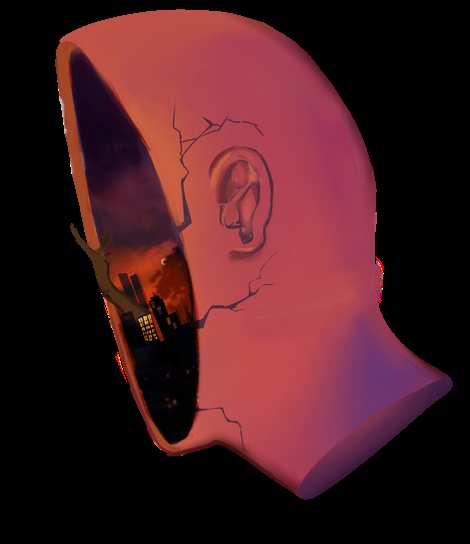


by RIJERIS CAÑEDA



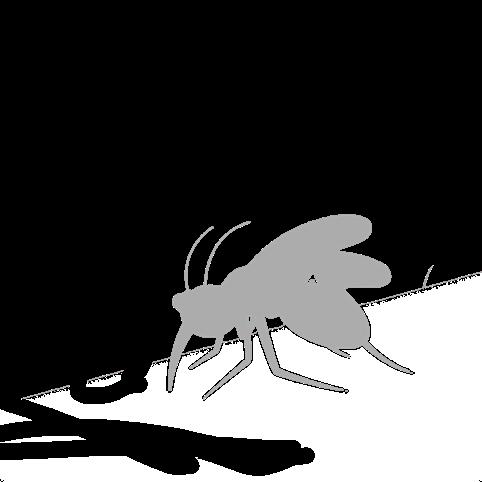
Unpaid balance demanded by COBI to COWD, which the latter didn’t acknowledge.
schoolnews by
Dengue affects 2.5% studes, cases spike
ERICH BETE
In a recent survey by Nudo Veritas, 2.6% of Regionalistas were affected by dengue brought about by recent flooding, showing a notable spike throughout August to October.
The survey showed that out of 1,234 students, 2.6% or 32 Regionalistas suffered from the disease with August being particularly high with 19 cases,
while September had eight cases and October had the fewest number— only five. Adam Manlunas, the school nurse of Gusa Regional Science High School- X (GRSHS-X), shared that the rising cases are related to the trend in statistics which shows an increase in dengue cases is to be expected following the dry season.
“Recurring fever, low grade to high fever and then dili siya ma cure with paracetamol, stomachache, body pains, and if ever naa man gani recurring fever dapat mag pa-check sa doctor,” Manlunas added. In relation, Grade 11 GRSHS-X student Louise Villar who contracted the disease, shared that her fever went on and off for one week before being
Amid rising road accidents, April 2024
P16.60/m 3
rate by COWD since
rate by COWD since 2024 whereas the debt disputed is the total amount difference of the agreed rate and increased rates.
source: CDO Water Distract
Water crisis 40% of city’s household is affected by the CDO water crisis.
source: Rappler & INQUIRER
DRAINED BY DEBT
40K Kagay-anons suffer from COBI-COWD debt dispute
by DAWN MEJARES
Disconnection of water supply by Cagayan de Oro Bulk Water Incorporated (COBI) to Cagayan de Oro Water District (COWD) over a P479 million debt dispute raised struggles among residents, where 13 villages with 40, 000 households in Cagayan de Oro City were affected.
On May 14, COBI confirmed that the main supply valves leading to the water district’s distribution had been closed which sparked frustrations among affected students and residents.
“Makasapot kaayo especially sa paghugas og plato kay kapoy jud mag kabo-kabo ang pagkuha sa tubig. Usually, mag-atang mi from 1 AM to 4 AM para maka-salod,” Grade 11 student, Sabrina Curit, lamented as no words could explain enough the problem in their residence in Upper Carmen.

Meanwhile, Pashka Resoso, a grade 10 student, voiced out that this extensive crisis left her and her family struggling over a once-easy task of using a faucet for chores and toiletry needs in Canitoan.
“Frustrating kaayo, imbes easy lang unta mag on sa gripo. It was so hard living a life without water for days,” Resoso expressed.
CURBS TAP WATER
USAGE DESPITE HEAT
Curit mentioned that they purchased five gallons of mineral water per day, limited their baths, and always used an electric fan to survive against the heat at the same time, emphasizing the struggles of enduring the heat amid the water scarcity.
“Kung mag CR [comfort room] ko, I go directly to the mall [unless urinating]. Additional expenses kaayo,” Curit added.
Resoso, on the other hand, also emphasized how the water crisis has altered their schedule amid school days.
“If school days, maligo jud mi sa night time kay sa night time ra man jud naay water. So lisod for us na ‘pag init kaayo then dili mi kaligo," Resoso stressed.
LOCAL RESIDENTS’ STRUGGLE
The villages affected consisted of Iponan, Bulua, Patag, Upper Carmen, Canitoan, Pagatpat, Camaman-an, and portions of Lumbia, Lapasan, Gusa, and Macasandig, Barra and Igpit in Opol, comprising 40% of the city’s household.
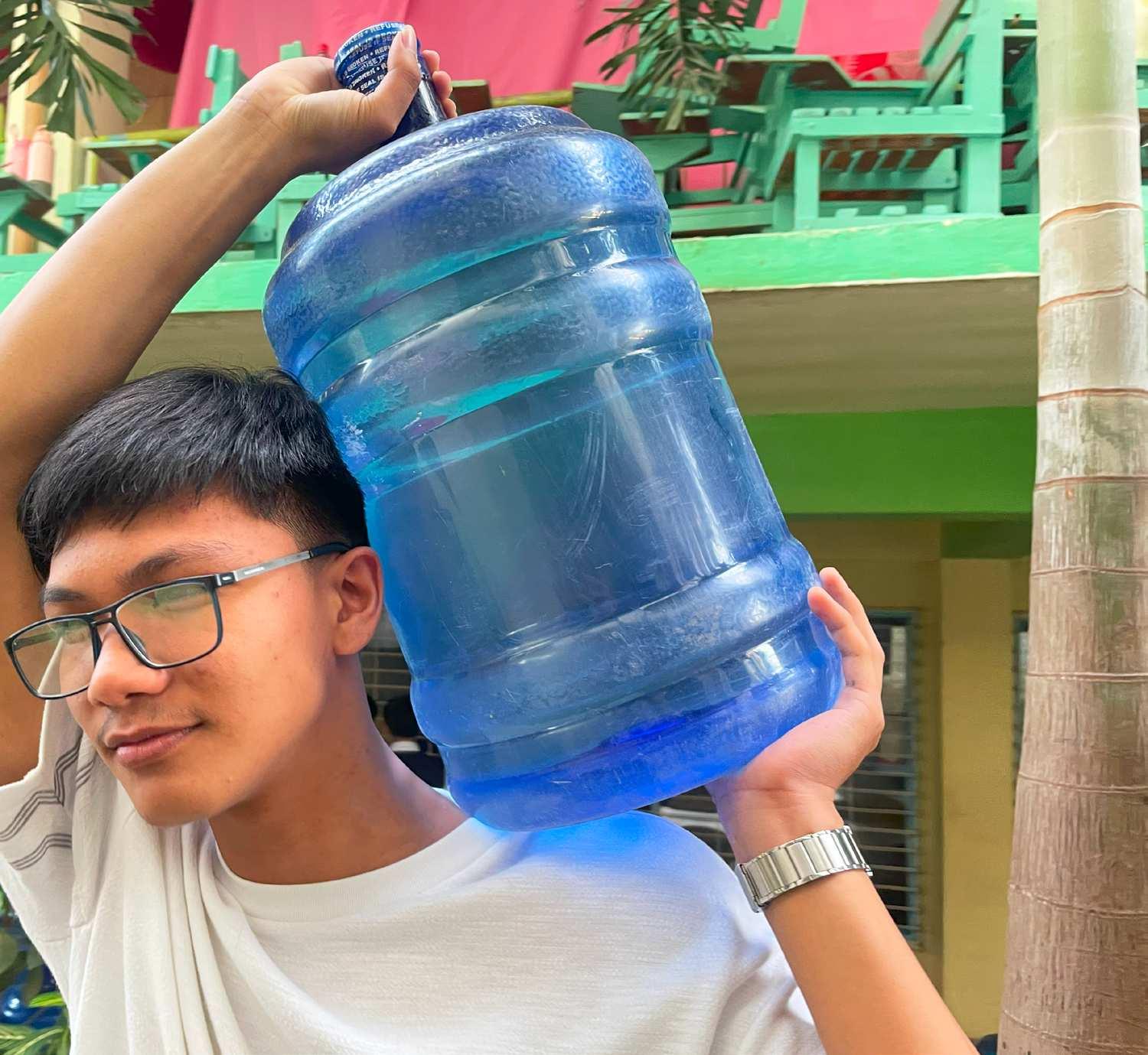
600 houses down in Camp Evangelista demolition leaves studes, families, kins in dejection
by NICOLE ROJO & DAWN MEJARES
House demolition in Camp Edilberto Evangelista, Patag, Cagayan de Oro City last June 18-21 sparked dejection among students and families affected, leaving 591 houses dismantled for military reservation in the areas.
The demolition is in line with the implementation of the Supreme Court ruling dated November 20, 2013, declaring a total of 42.29 hectares of communities of former soldiers residing reverted to the public domain.
“We know the families of the soldiers will be hurt by our decision, but the Philippine Army also needs this land for barracks and training facilities,” the chief of the Philippine Army Real Estate Office, Major Joseph Say, stated.

Vash Sarapuddin, a Grade 11 student of Gusa Regional Science High School
- X and a former resident of Camp Evangelista, stated that the demolition was postponed multiple times
but was pushed through in June.
“Dugay ra nga naa jud talk about demolition sa kampo, pero wala namo gi expect nga mahitabo najud diay [sa June],” Sarapuddin expressed.
Meanwhile, a Grade 11 student from Misamis Oriental Institute of Science and Technology and an exresident of Camp Evangelista, Helenah Bahia, voiced out that most of the residents were disappointed and their initial response was to fight for their place.
“Pero kato mga days to prepare namo kay wala namo gi [gamit pang] prepare kaayo. Gipaglaban ra instead. Amoang yuta, among house, among campo,” Bahia stressed.
Bahia expressed that the demolition was not justified, leaving her and her family weeping for they have lived there for many years.
A 37-year-old affected local resident in Bulua shared her struggle, stating that although they had stored water beforehand, it was not enough for their usage.
“Nabalaka [ko], kay nadungog-dungog atung panahona nga dugay pa mawala ang supply sa tubig,” she added, sharing the emotions she felt amid the crisis.
ROOTS OF DISPUTE
According to a statement released by COBI, COWD has not provided a formal response regarding the outstanding balance owed, stressing that the payments are essential to ensure continued water operations.
Meanwhile, COWD General Manager Engr. Antonio Young has explained that the collectibles demanded by COBI is the total amount difference between the rate increased by COBI in 2021, from P16.60 to P20.57 per cubic meter, and in 2024, to P24.19 per cubic meter.
“We indicated [upon receiving the notice of collection last April 18] that the [COWD] Board of Directors in 2021 has invoked force majeure [due to the impact of COVID-19 pandemic],” Young said in a press conference, pertaining to their rate adjustment contract with COBI.
“Ang COWD walay utang sa COBI,” Young has already contested last April 8, implying that COWD has not missed its payment to COBI at an agreed rate of P16.60 starting from 2017.
Despite this, COBI assured that they are committed to work with COWD as they are available to provide a swift solution.
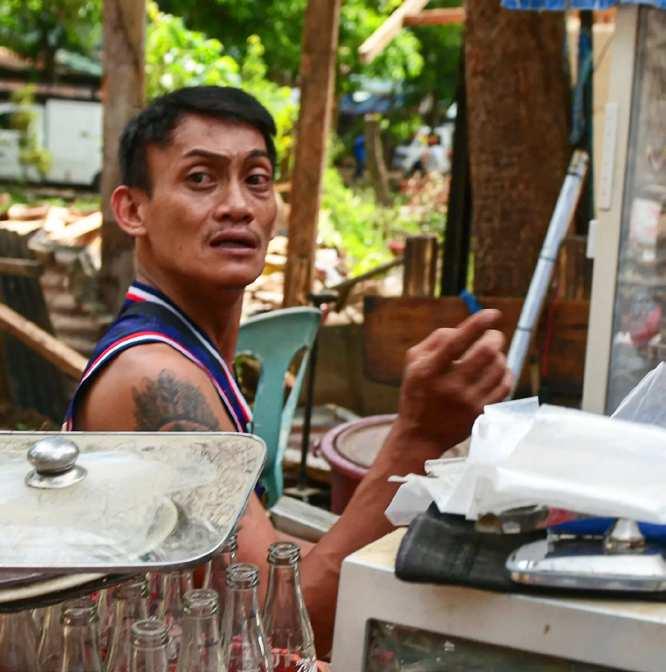


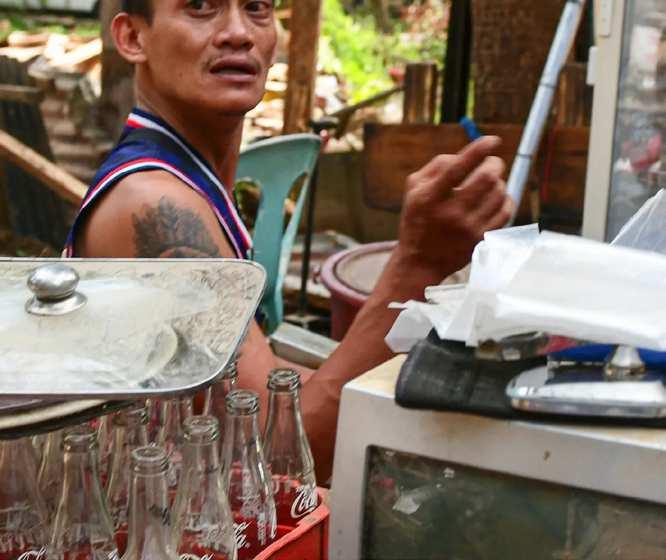
City Council pushes for reinforcement of antijaywalking measures by NATALIE
PALTINCA
As road accidents increase in Cagayan de Oro (CDO) City, City Councilor Roger Abaday promoted reinforcing the anti-jaywalking ordinance in response to the special report of City Councilor Suzette Magtajas involving drivers who do not stop in pedestrian lanes with people crossing along them.
According to Abaday, one of the causes of road incidents is not only because of drivers who disrespect the use of pedestrian lanes but also the people who jaywalk.
“I propose the codified ordinance on pay parking and jaywalking and I want the Roads and Traffic Administration to [update the penalties] so that the revenue will go to fund the enforcement of these ordinances,” Abaday said in an article with Mindanao Gold Star Daily.
Moreover, the City Councilor suggested that traffic enforcers should be assigned to areas outside schools to assist students in crossing the road safely and to construct footbridges in high-traffic zones.
“Maayo kung mabalik ang anti-

SET A
Grades 7,8, & 11
Grades 9,10, & 12 6:3011:50 AM 12:105:30 PM
Shattered Hope: Jeepney drivers voice frustration after PTMP suspension rejection
by NATALIE PALTINCA
Jeepney drivers breathed a quick sigh of relief after being given the possibility of the modernization program’s suspension, only for their hopes to be crushed as the government rejected the resolution.
Local jeepney drivers in Cagayan de Oro City expressed disappointment after the proposed suspension of the Public Transport Modernization Program (PTMP) was rejected by the Department of Transportation (DOTr), leaving them struggling to cope with the modernization program.
“Kana daghan gyud epekto kay kaming jeepney [drivers and operators] ang luoy. Kanang ilang mga bag-o karon kay mahal, di ka afford ang uban,” commented Owen, a jeepney driver. Owen added that the continuation of the program would not alleviate their lives, instead, it would have a negative impact on drivers and operators who have families to support.
Additionally, Adam, another jeepney driver, explained that their income had been affected after the program was implemented due to increased competition for passengers.

42.29 hectares (communities reverted to the public domain) 129 hectares (total landareaofCamp Evangelista)
TAKEOVER. A Camp Evangelista resident prepares to move out of the area as demolitions by the Philippine Army affecting 591 houses take place. Camp Evangelista, Cagayan de Oro, Misamis Oriental. June 23, 2024. Photo by 4th Infantry Division - RAPPLER.
“Ang income sa jeep minus na gyud kaayo. Yahay mi ron kung makab income na mi og P500 sa kada adlaw, arang-arang to sauna kay makadala pa mi og libo kapin,” said Adam. Furthermore, Roque, a jeepney owner, shared that he was only able to assume the jeepney he used to drive because of the earnings he made from driving it and that they would not be able to afford the new jeepney units as their prices are too expensive.
“Angay jud i-suspend kay daghan mawad-an og kita [...] kung pagbuot gyud sa gobyerno nga idayon sya, wala na gyud mi mabuhat mga drivers og operators,” Owen added, highlighting that it would be acceptable if the program continues and if the government provides support to the affected drivers and operators.
Meanwhile, DOTr Undersecretary Andy Ortega reasoned that they will pursue the continuation of the program as all matters can be fixed through consultations, and DOTr is addressing the issues through ongoing review and stakeholder consultations.
GRSHS-X SSLG presents 2nd quarter
GRSHS-X’s
schoolnews
SPLIT SESSION
RS adapts two-class shifts for displaced sections amid construction
by NICOLE ROJO

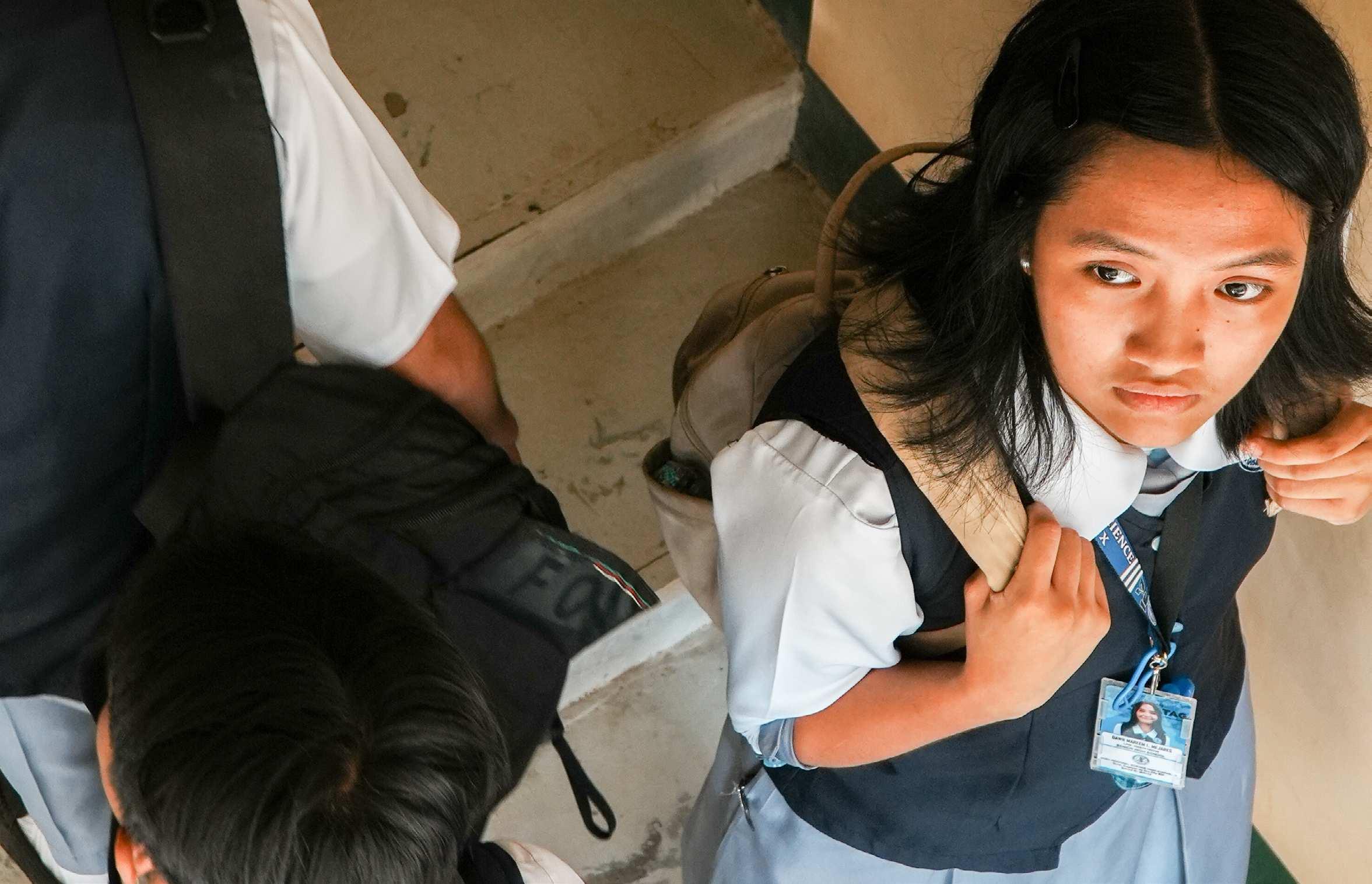

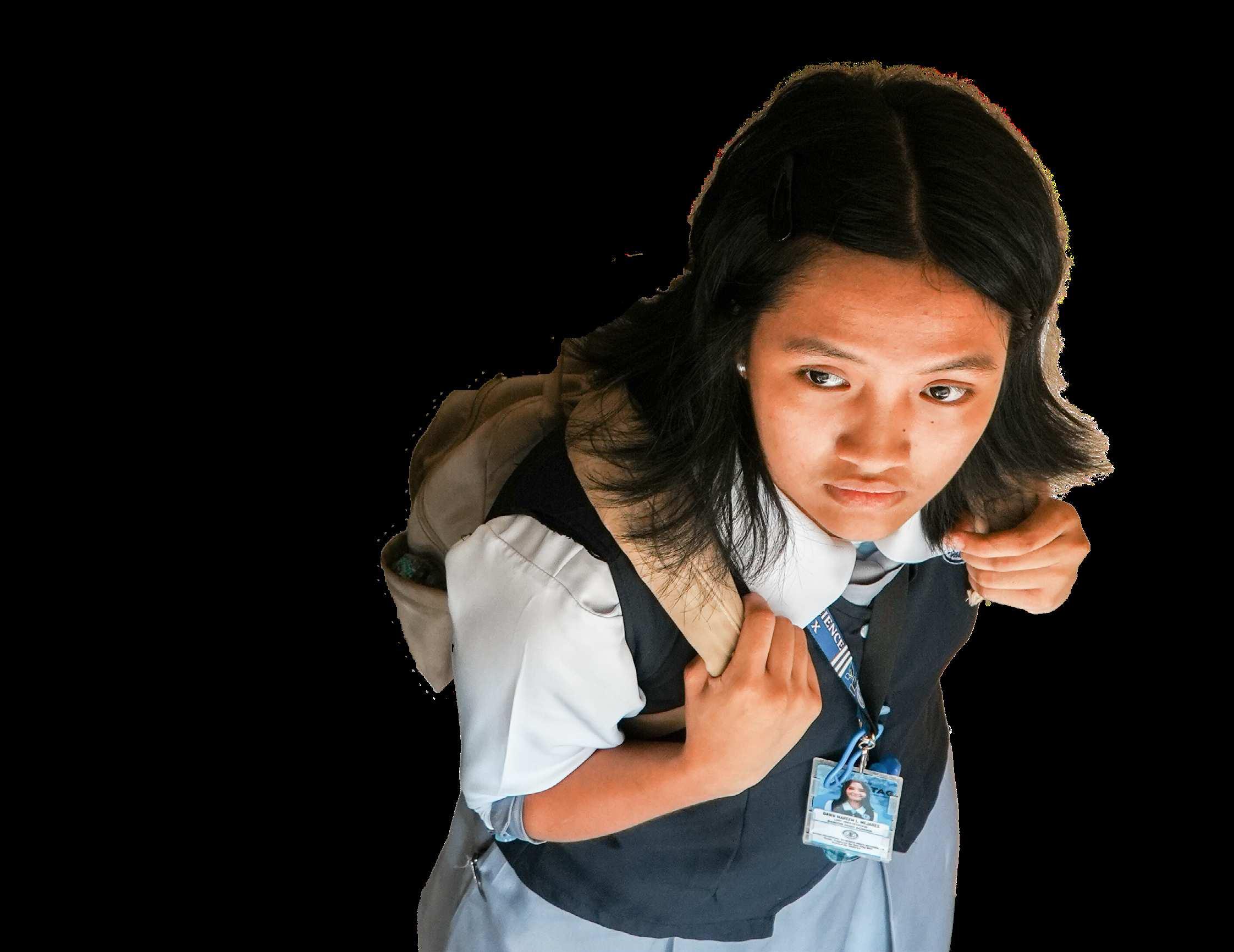
After years of whole-day classes, Gusa Regional Science High School-X (GRSHS-X) implemented Set A and B schedules after demolishing two academic buildings, resulting in two class shifts and the sharing of classrooms.
Five out of 34 sections were displaced following the demolition of the school’s old buildings to make way for Mayor Klarex Uy’s 4-storey, 16-classroom project, and the Department of Public Works and Highways 2-storey with eight classrooms construction, as a result, the displaced sections had to share classrooms with other classes, leading to the implementation of morning and afternoon schedules.
“We have no other options but [to] consider the schedule,” Assistant School Head Maria Louella Roz de Gracia Raut expressed.
GRSHS-X is the only school in Cagayan de Oro City to implement
coverstory from 01 NorMin ranks 5th...
two shifts, not due to overpopulation, but due to classroom shortages caused by constructions with the new schedule separating the grade levels— Grades 7, 8, and 11 in Set A and Grades 9, 10, and 12 in Set B.
This new regulation has impacted students’ routines, with morning classes starting at 6:30 a.m. and Set B students dismissing at 5:30 p.m. with the junior high school students having 45 minutes per subject, while an hour for senior high school students.
Grade 11 student Gayle Escobido expressed that being under the morning schedule, she had to adjust her body clock, moving her wake-up
Sugar dating linked to STIs- study
Sugar dating raises the risk of STIs as Kirkeby et al. (2021) revealed that 72% of the sugar babies they interviewed took part in sexual contact about two to four times a month.
The study was conducted among 329 women of whom 77 were sugar-dating and they concluded they were twice as likely to be diagnosed with an STI.
Meanwhile, the Department of Health Secretary Dr. Teodoro Herbosa noted the 538% increase in the Acquired Immunodeficiency Syndrome-related deaths nationally between 2010-2022 while highlighting that there are 50 new cases daily with 47% of them being 15-24 years old in 2023.
“Sugar dating blurs the line between companionship and financial transaction leading to exploitation and harm … while its similarity to prostitution raises questions about consent,” Miel expressed.
In relation, Manzanilla et al. (2024) concluded that the adolescent girls they interviewed lacked sexual education as some said that squatting after sexual intercourse avoids pregnancy.
“Paano ito nangyari? Alam ko kung ano ang ginawa ko, ngunit hindi ko inaasahan na mabuntis,” a 15-year-old participant answered.
These rising cases have prompted Senator Risa Hontiveros to refine the Senate Bill No. 1979 also known as the Prevention of Adolescent Pregnancy Bill.
“The bill is a reasoned … response …, I deem it better for us to be united in our goal to bring down teenage pregnancy,” Hontiveros said. Infant mortality soars among teen mothers
Multiple research has concluded that infant mortality rates are higher for babies born to teen mothers due to factors such as unintended pregnancies and limited access to prenatal care.
Manzanilla et al. (2024) revealed that pregnant teens were expelled from their homes leading to a lack of emotional support.
“Binugbog ako ng papa ko nung malaman nya …, tapos ikinulong ako sa bahay… dahil dito… dinala nila ako sa clinic pero sabi ng doctor wala na daw ang baby ko,” another participant explained.
To combat this, Ob-gyn Aletha Y. Akers believed that teens should have full access to sexual education and reproductive health services.
by JOANNE TOCALDO
time from 4:45 a.m. to 4:10 a.m. to attend her classes on time.
“You have to wake up early since 6:30 a.m. ang class, tendency sad ani kay dili ka maka paminaw ug ayo since usahay sleepy paka [during class],” Escobido expressed. Despite having to wake up early, Escobido added that she likes the flexibility of the morning schedule since can go home early and work on personal things in the afternoon. On the other hand, Jaeve Butcon, a Grade 10 student under the afternoon schedule, expressed his frustration with not understanding the lessons in a 45-minute period.
“As a student, needed ang at least one hour each subject to learn more and para pud sa mga students na dili fast learner,” Butcon said. Meanwhile, teachers are also affected by the 45-minute classes as they have to fit the lessons into the new schedule.
“At first, kapoy kaayo kay hectic ang schedule but later on naka adjust nako,” commented a certain teacher.
Raut explained that this new schedule is only a ‘band-aid solution’ to the classroom shortage and will resume its usual schedule after the construction.
To improve the teaching and learning process specifically in Information and Communication Technologies (ICT) subjects, the school was part of the Department of Education (DepEd) Computerization Program (DCP) which provides public schools with ICT equipment.
Improving ICT equipment in schools, With
Tan added. Meanwhile, the student Chloe Gabrielle B. Te was happy to borrow the laptop and its accessories as it can improve her technical skills with her team during the Division Schools Press Conference in Secondary Filipino TV Scriptwriting and Broadcasting. Tan hoped for the program to improve its technical aspects in future batches through
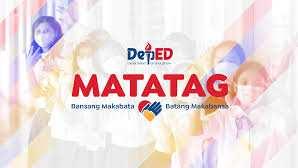


Budget Cliff: GRSHS-X Canteen Prices Clash with NEDA’s ₱64-a-day Food Poverty Threshold

The students find themselves standing over a treacherous cliff due to the rising canteen prices which are well above the daily food threshold of ₱64 per person set by the National Economic and Development Authority (NEDA)
On August 13, NEDA considered individuals spending at least P64 per day on three meals as not ‘food poor’, claiming a little over P20 for each of the three meals needed daily sparked discussions among GRSHS-X students as they felt that even a single meal at the school canteen surpasses this amount, raising concerns about the practicality of this benchmark in the true cost of living and real-world conditions.
With typical canteen meals costing between P30 to P50 each, a full day’s meals far exceed NEDA’s daily poverty threshold of P64, leaving students who rely on limited daily allowances struggling to afford balanced and nutritious meals.
“Even if students will budget their allowance a day, it is still not enough jud kay ang mga individual and simple snacks at the canteen averagely cost P10 to P15 each na and dili pa ni enough na maka busog sa students. If we’re going to talk about
meals sad, it exceeded this budget na even if for lunch lang. If you add lunch and snacks overall, P64 isn’t realistic,” Gusa Regional Science High School-X Grade 12 student Marvie Rose Torres shared. Torres added this threshold not only affected the financial aspects of
In response to criticism of its per-meal metric for food poverty, NEDA clarified that the food threshold is a tool for measuring poverty, not a budget for a decent standard of living; however, citizens still view the threshold as insufficient and out of touch with the realities faced by Filipinos.
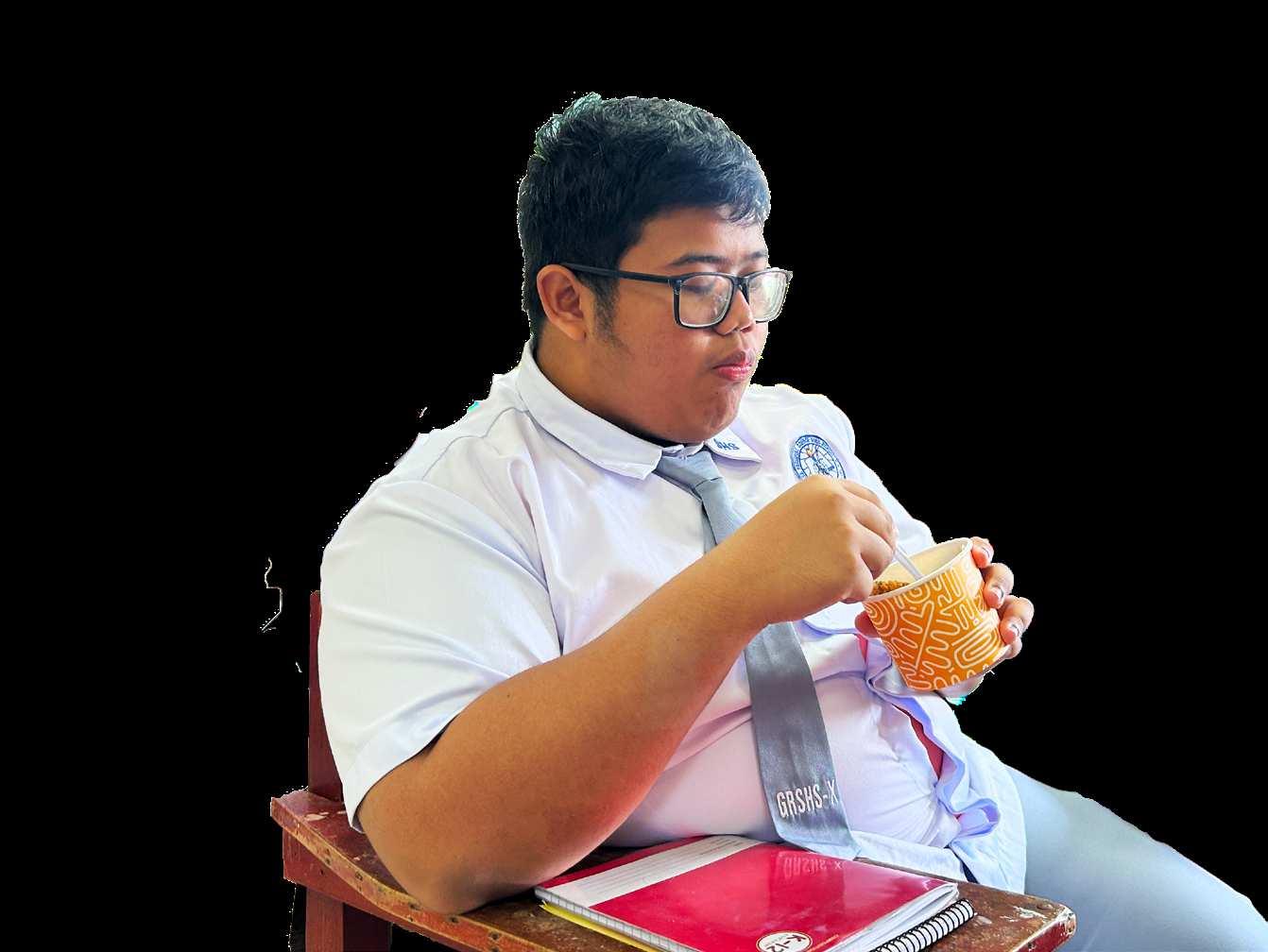


SPLIT. A senior high school student exits the campus after her morning classes to give way to the incoming wave of afternoon session students, amidst the Set A and B class scheduling at Gusa Regional Science High School, Cagayan de Oro, Misamis Oriental. November 8, 2024. Photo by LANCE
Photo by LANCE DABAD



PRICE PAID OF SILENCE
Our city has grappled with the scourge of online sex trafficking, casting a shadow over the
youth. In response to this, the city government has announced a
After all, the unfortunate truth is that the local government system—who will bear the responsibility of carrying out these efforts— and the Philippine justice system, are no strangers to corruption and systemic failures. As it goes to show, this record proves to be much larger than any promising project that will ever be.
The Tri-City Justice Zone, launched on September 2024 by the Justice Sector Coordinating Council (JSCC) is a pioneering initiative that seeks to battle online sexual abuse and exploitation of children (OSAEC). Justice sector institutions of three cities—Cagayan de Oro, Iligan, and Ozamiz—will adapt a system of coordination and communication to create an effective approach towards battling these atrocities. In the words of Department of Justice (DOJ) Secretary Jesus Crispin Remulla, “The Tri-City Justice Zone shall strengthen this resolve to combat these crimes using all resources at our disposal.”
Additionally, the three cities were chosen due to their titles of holding the highest incidences of OSAEC in the region of Northern Mindanao. Since 2003, they have also had the highest number of convictions for OSAEC, human trafficking, and other related offenses. In the United Nations Children’s Fund (UNICEF) statistics from 2016, it is reported that a total of 80% of Filipino children are vulnerable to online sexual abuse and exploitation. These cases worsened throughout the pandemic, with data from the US-based National Centre for Missing and Exploited Children (NCMEC) stating that
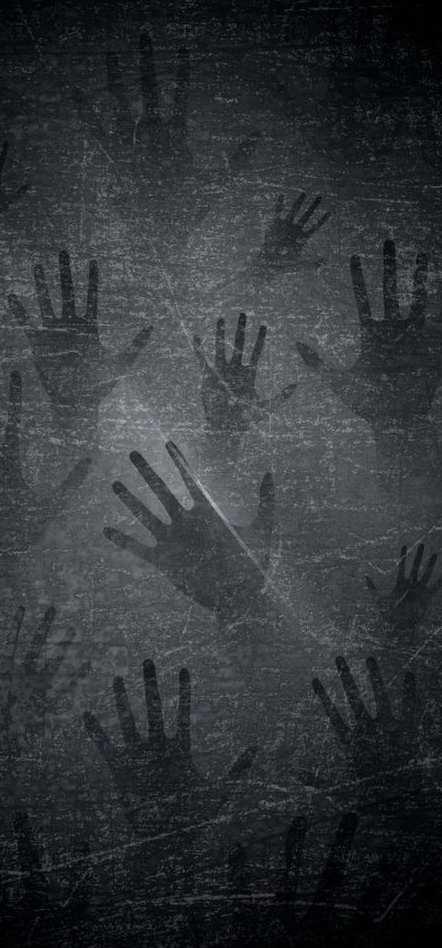



However, even with its air of praise, it remains bounded with skepticism.
compared to the 76,561 cases reported during the same period in 2019, the number of OSAEC cases in the Philippines grew by 264.6 percent, or 202,605 more reports, during the implementation of the enhanced community quarantine from March to May 2020. With all these alarming numbers on a constant rise, the need for immediate action is as evident as it is necessary. The Tri-Justice zone program, ostensibly robust and equipped with state-of-theart monitoring technologies, has been hailed as a significant leap forward in protecting at-risk individuals. It even gained so much as a firm support from the European Union (EU), emphasized by Ms. Ana Sanchez Ruiz, Charges d’Affaires and Deputy Head of the Delegation of the European Union to the Philippines. On paper, this initiative is everything the city has long needed: an alliance between law enforcement, social services, and technological oversight that promises a safer digital space for the city’s citizens, particularly its youth. However, this glimmer of hope should not outshine the history of injustices that speak for itself. Firstly, the country is no stranger to the countless cases of sexual exploitation within
schools. Since its launch in 2022, the Department of Education’s (DepEd) student safety hotline has received just 70 reports of sexual abuse. There is “no way” that just 70 occurrences happened over that time period, according to advocacy groups like Enough is Enough, who have disputed this figure as being wildly inaccurate of the incidents that actually happened in schools. This shows an alarming
the testimonies of numerous individuals and even deems it to be fabricated by disgruntled people. The judicial system somehow finds it a difficult feat to persecute a prominent name that is a scapegoat of a heinous crime.
in governmental culture to succeed - all of which have been nothing but futile goals throughout the years.
Citizens have grown weary of empty promises and halfhearted attempts, and they are acutely aware that without rigorous oversight, this anti-trafficking endeavor might follow a disappointing and predictable course.
case of underreported incidents, implying a gap in accountability and transparency within school systems. Additionally, look into the case of Apollo Quiboloy, whose persecution has been drawn out despite cases of sexual abuse and human trafficking of the members of his own church. Unsurprisingly, he denies
The aforementioned cases are only a tiny fraction to the whole scope of sexual trafficking, and even cybersexual abuse. Historically, the Philippines does not have an appealing record when it comes to justice given to human trafficking cases. With this, it raises the pressing question of whether or not the Tri-City Justice Zone project will follow the trajectory of its predecessors, or somehow break free from the cycle of corruption that has stymied progress for years. Prior programs with similar noble goals have crumbled under the weight of bureaucratic inefficiency, misallocated resources, and outright mismanagement.
Quite frankly, taking initiative is the bare minimum in being a public official. However, talking about smooth and proper implementations of these programs are a whole new aspect to be acknowledged. Though it offers a realistic start to eradicating society’s menace, it will require unprecedented transparency, accountability, and a shift
Citizens have grown weary of empty promises and half-hearted attempts, and they are acutely aware that without rigorous oversight, this anti-trafficking endeavor might follow a disappointing and predictable course. For the city’s leaders, this is an opportunity to rebuild public trust and demonstrate that meaningful change is possible, but it must be backed by tangible results, not hollow assurances. The stakes are far too high for this to become yet another project whose funds are siphoned off or whose leaders falter under pressure, leaving vulnerable lives unprotected.
The burden lies with the government to prove that it can transcend its previous failings and truly prioritize the well-being of its citizens. The initiative has the potential to dismantle a vile industry that profits from exploitation, but only if those in power take their role seriously and resist the lure of complacency or corruption.
As this program takes shape, one can only hope it stands as a testament to positive transformation, not as yet another failed venture mired in controversy and disappointment. The future of the city’s most vulnerable rests upon the government’s ability to act with integrity, vision, and unwavering dedication to justice. After all, the point is not to dim the venture, but to reflect on the past and even present injustices that showcase the very incident of a faulty government.
art by VANESSA PINTOR


decayingpromises
by MIKAH MABULAY Rusting
Irony
A country where millions of its houses are topped by metal roofs should know that the salvaging of a rusted roof is a lost cause, for no amount of new paint over rusty metal could restore it to its former strength and function.
For every administrative term, the winning presidential candidate always attempts to adhere to the campaign slogan that earned them the presidency.
Although in Ferdinand Marcos Jr.’s initiative of a ‘Bagong Pilipinas,’ he is not materializing a brand-new Philippines, but rather merely enforcing a new brand upon it.
52 years after Filipinos propel a dictator’s descendant into power, Marcos Jr.’s ceaseless attempts to perpetuate historical revisionism in our education systems are shrouding reality. As a false agenda of his father’s heyday promotes the brand of a ‘Bagong Pilipinas’ where reformed Philippine governance and leadership is apparent—it is an ironic claim for a country where
When education becomes more of a privilege than a right, equity is a heavier discussion in basic education.
declaiming slightly less regressive ideals are demanded recognition.
Albeit being cut out of the same cloth, the contrast bias between Duterte and Marcos Jr. paints the latter as some saint, reinforcing the reasons for his current performance appeal of over 69% to the general public. The six years of Duterte’s ironfisted tenancy in the Malacañang made way for political dynasties, corruption, media censorship, and human rights abuses to run rampant and thrive—shamelessly displaying his brand of violence under the guise of discipline and order.
Now, contrary to the previous ragged branding, Marcos Jr. strategized on paying homage
to his father’s nonexistent heyday as a dictator, branding the ‘Bagong Pilipinas’ as a medium to promote unity. In an uncanny parallel, the late dictator Ferdinand Marcos Sr. guised absolutistic initiatives for a ‘Bagong Lipunan,’ structured on campaign promises of national development. However, as he banked on the social unrest borne by his own incompetencies, he abruptly owed the Philippines an irreversible debt—one that a simple ideology could not resolve.
Recently, Marcos Jr. shunned one of the ripest reformable systems to avert focus on — concise education reforms and anchored planning to alleviate the education crisis. Then again, this field of neglect reflects on
the infringements he is guilty of: censoring and wiping the severity of the Marcos’ atrocities in textbooks, and ultimately, depriving future generations of a pivotal knowledge of our nation’s resistance to oppression.
To simply paint over a rusted roof, will not miraculously heal it of all its accumulated deterioration on the surface. Endeavors of a ‘Bagong Pilipinas’ are only a piece of the puzzle. Until then, we will never live to see the day where our country would be in a better state than we began, and the aspirations of a ‘Bagong Pilipinas’ will continue to rust, added to a pile of unfulfilled politician campaign promises.


bitingthroughinnocence
Silence is Not Absence
by LHIAN BRANZUELA

College education in the Philippines recently became a hot topic when the “burgis na nasa UP” discussion emerged. This debate started when a University of the Philippines (UP) student, Bethany Talbot, posted a TikTok video of her replying to a comment saying “burgis na nasa UP? lololol,” suggesting that the rich – the bourgeoisie or the “burgis” – studying in the University of the Philippines, a state university, is questionable and ironic. This sparked a heated debate among netizens, as state universities are public institutions that are funded by the government and have no tuition fees.
The University of the Philippines is known for its academic reputation and status as an academy providing free quality education for all. However, as UP gains more and more reputation, more students of different socioeconomic classes are eyeing on getting to become a UP student.
UP is recognized as the Philippines’ “national university” stated in the Republic Act No. 9500 entitled University of the Philippines Charter of 2008. In Section 9 (Democratic Access), it is expressed that the national university
We cannot deny that more opportunities are given to the privileged compared to the poor masses. So, instead of arguing with the rich, raising concerns regarding the accessibility of quality education in all public schools would be more productive and paramount.
shall strive to enhance the access of disadvantaged students to its programs and services.


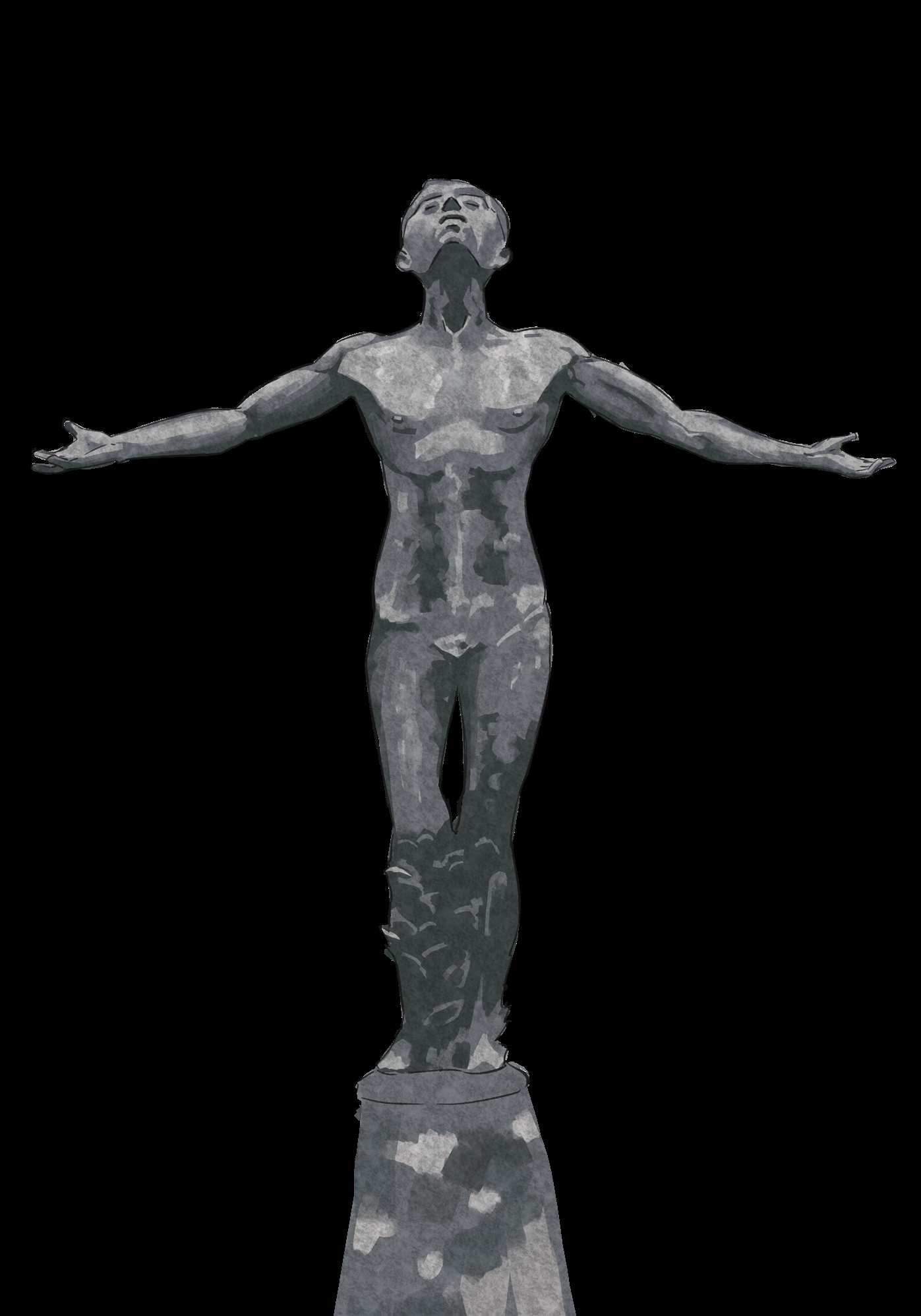

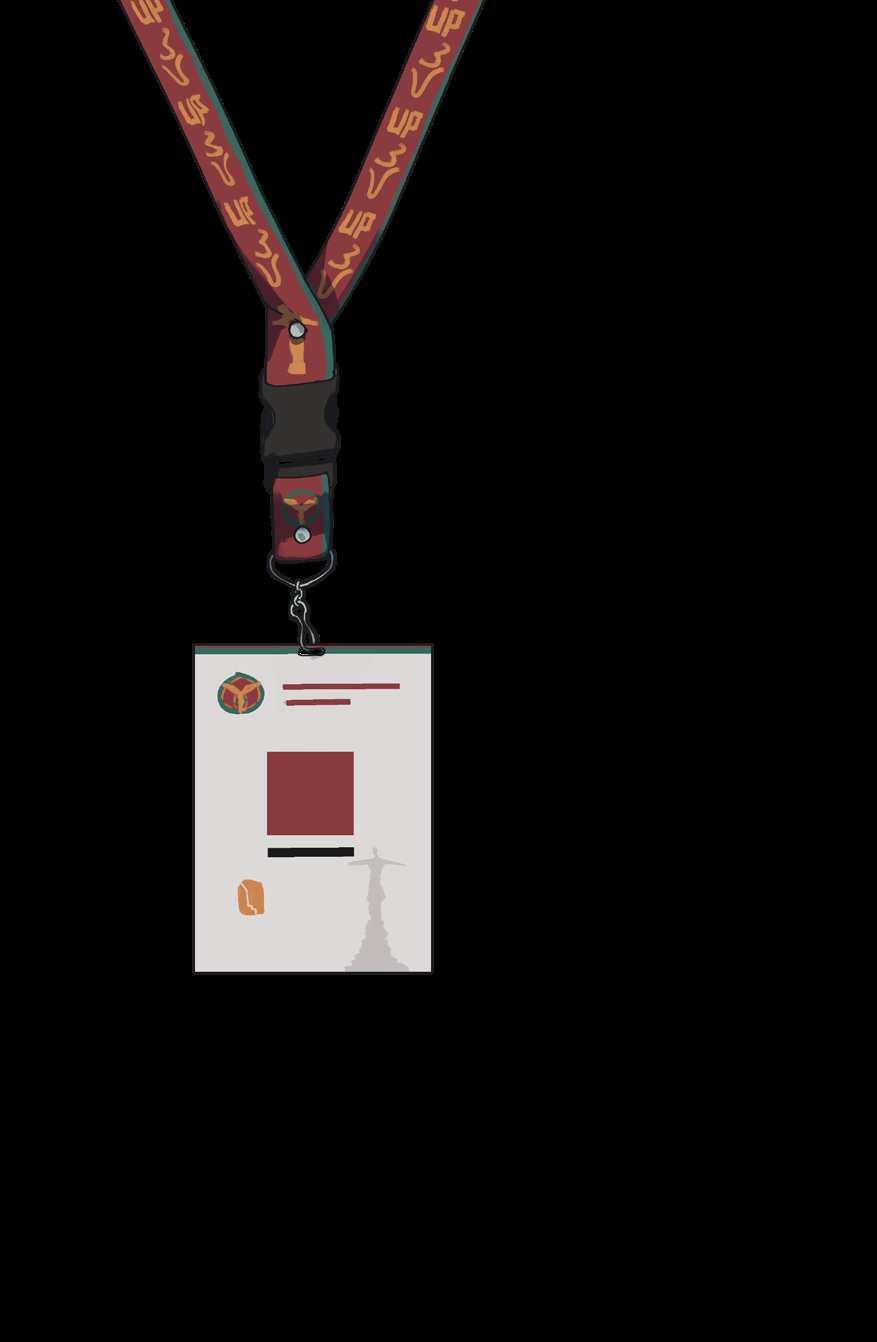
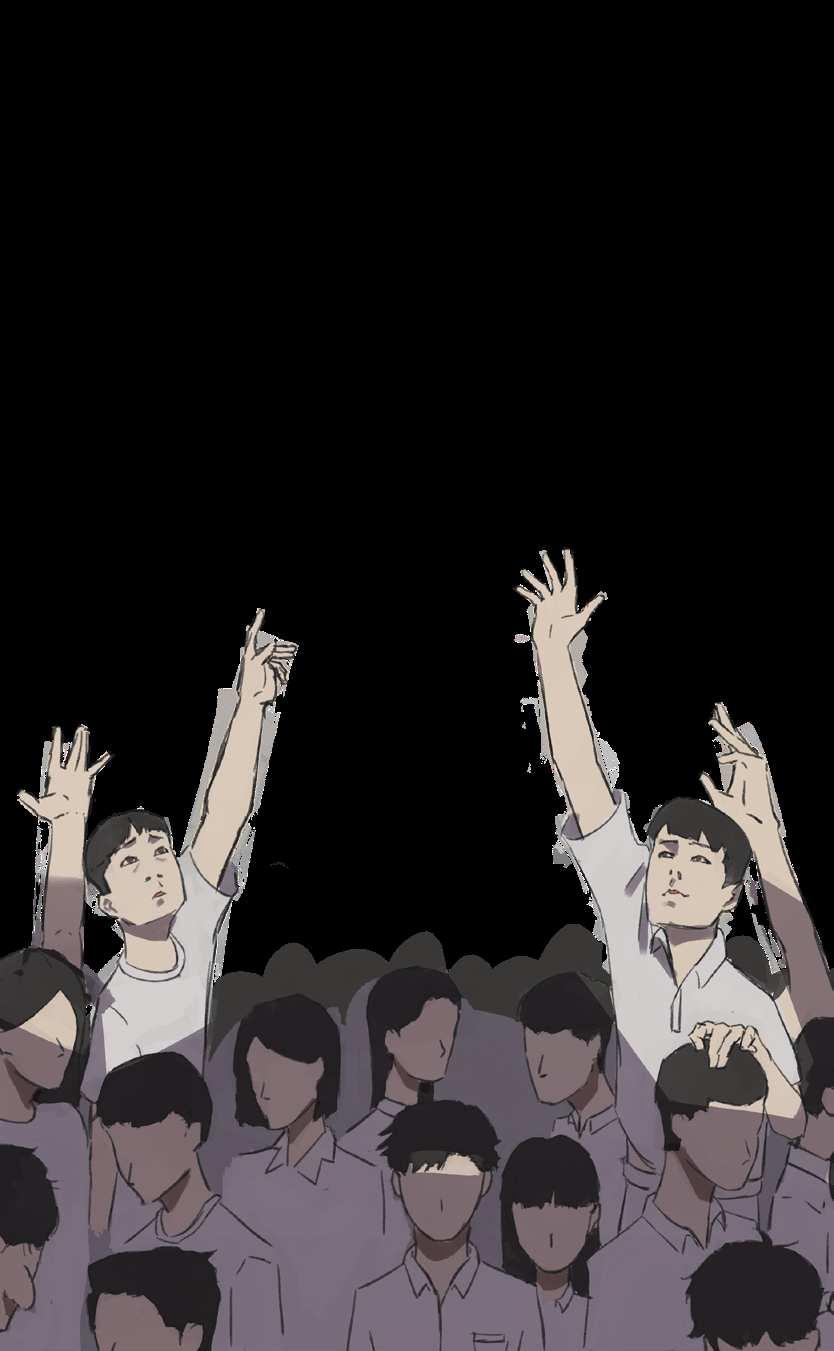
From Trees to Novelties
The idea of the rich entering a university that is more beneficial for a less-fortunate class can truly enrage the average person who is aware of the unfairness of offered opportunities. Some say that the wealthy should give up their slots in the UPCAT (UP College Admissions Test) for the underprivileged to take since they can afford other universities that are otherwise not accessible to those who cannot afford tuition. This also goes for all state universities, in accordance with Republic Act No. 10931 or the Universal Access to Quality Tertiary Education Act. However, deterring the rich from their right to choose UP as their college is unfair to them. The University of the Philippines does not favor any class, but only those who pass the UPCAT. They do not choose based on the socioeconomic statuses of the applicants, but their levels of intelligence based on the academy’s standards. Their status should not affect their worthiness to enroll in UP. On the other hand, an argument could be made that the rich yield higher results since they have better access to proper and superior quality education in private schools and easier access to review centers, rather than those in public schools with a lesser quality system and a less attainable means to afford additional education.
This fact puts upcoming college freshmen in a tight position. To do your best, knowing that there are students with more advantages giving lesser effort and still coming out on top, is downright draining and discouraging. The pressure that students from a public school, much more from a science high school, is very much present.
Overall, it is all a matter of accessibility. We cannot deny that more opportunities are given to the privileged compared to the poor masses. So, instead of arguing with the rich, raising concerns regarding the accessibility and quality of education in all public schools in order for the less fortunate to keep up with the students who can easily access tools to reach the opportunity would be more productive and paramount.
The issue is not with the rich, but with the unfair system that has the poor
by LHIAN BRANZUELA
As all sectors of the country now bear the brunt of every wrong vote, good governance is a farfetched possibility. At a time of sensationalized propaganda and idolatry, the epitome of a good politician is synonymous with a camera-friendly charm and a politically-inclined family tree. But even as the Philippines faces incompetence in their hands, it is evident that Filipinos just cannot get enough of novelties and dynasties in public office.
Television personalities and political dynasties have established their ground in Philippine politics. Previous terms have led to the further decline in almost all sectors in the community, especially in celebrities vying for positions without any experience in politics. According to a study in 2022, political families account for over half of all elected local government leaders and about 80% of members of Congress. Now, in the fast approaching 2025 elections, the Commission on Elections
(COMELEC) received 91 Certificates of Candidacy (COC) from Filipino celebrities running for positions in the local and national posts. With this growing trend, it is quite obvious that Filipino voters throughout the years have enabled them in the government. However, let us also remember that taking a closer look at it would prove that blaming the country’s misfortunes on poorly educated voters would result in nothing but discrimination and blindness to the bigger problem. After all, if the constitution grants us
the right to run for public office, let us not waste our vital right to make educated votes. As Filipino citizens, we have only come so far as to let Philippine society become a playing field for families who are too focused on their dynastic machineries to regard the actual state of the nation. As the future of Philippine governance, let us forbid showbiz names and political dynasties forfeit promising qualifications. After all, public office is a public trust; one that should be heavily rooted on experience and


knowledge in the field of politics. Shifting the standards to vast family trees and huge social media followings have heightened the need for voter’s education all the more. In a country where the youth encompass 52% of the total registered voters, it is up to us to shift the dynamics. Our very right to vote gives us the power to suppress dynasties and novelties from turning politics into a huge circus — lesser than it already is today.
Filipino societies have a penchant for placing unnecessary stigma on sex, under the guise of religion and mental purity. Yet, we must come to terms with the fact that sexual terminologies, despite silenced discussions at home, will always find their way into the minds and conversations of our youth. By then, it will only come to give itself an improper introduction.
Data from the Philippine Statistics Authority (PSA) stated that in 2022, registered live births by adolescent mothers aged 19 and below rose to 150,138. On average, this means that 411 children from teenage mothers were born every day. In 2023, Cagayan de Oro (CDO) recorded that 60 out of 1,000 live births were from teenage mothers.
Consequently, Senate Bill No. 1979, or the proposed Prevention of Adolescent Pregnancy Act, aims to introduce comprehensive sexuality education (CSE) in schools. But it faces heavy opposition—most notably from President Ferdinand Marcos Jr., who has controversially claimed that the bill teaches elementary students to masturbate. This fear stems from the logic that teaching young people about sex will encourage them to engage in it prematurely. However, global research consistently debunks this myth. Studies conducted by the United Nations and the World Health Organization show that countries with comprehensive sex education programs experience lower rates of teenage pregnancy.

These programs do not just teach surface-level knowledge about human intercourse; they emphasize consent, personal boundaries, and responsible decision-making. In a country where cases of sexual violence and exploitation of minors are rampant, equipping children with knowledge is not corrupting them—it is safeguarding them.
Moreover, the conversation about sex is already happening outside of classrooms whether we like it or not—through peers, social media, or their own experiences. Without proper guidance, they are only left to navigate them blindly.
Silence will not protect our children—education will. The danger lies not in teaching them about sex; it is leaving them to learn it the hard way. Once again, we are always reminded: ignorance is the greatest hindrance.

source:
art by AHMER MAGHINAY
Missed Education
studytheirony
AYUBAN
Impaired, But Aware
by AARON MOLDEZ
All talk, no sight–once again, the public finds itself blindfolded by extremely pessimistic shenanigans and irrational objections, turning down what benefits await the near future. Thus, we shamelessly walk with the most distorted, blurry, vision, both near and far. We are left to wonder: why must we refuse to put on the glasses that help us see the bigger picture?
19,
public alike frowned upon the idea, having such strong convictions that a change like that could perpetuate dishonest,
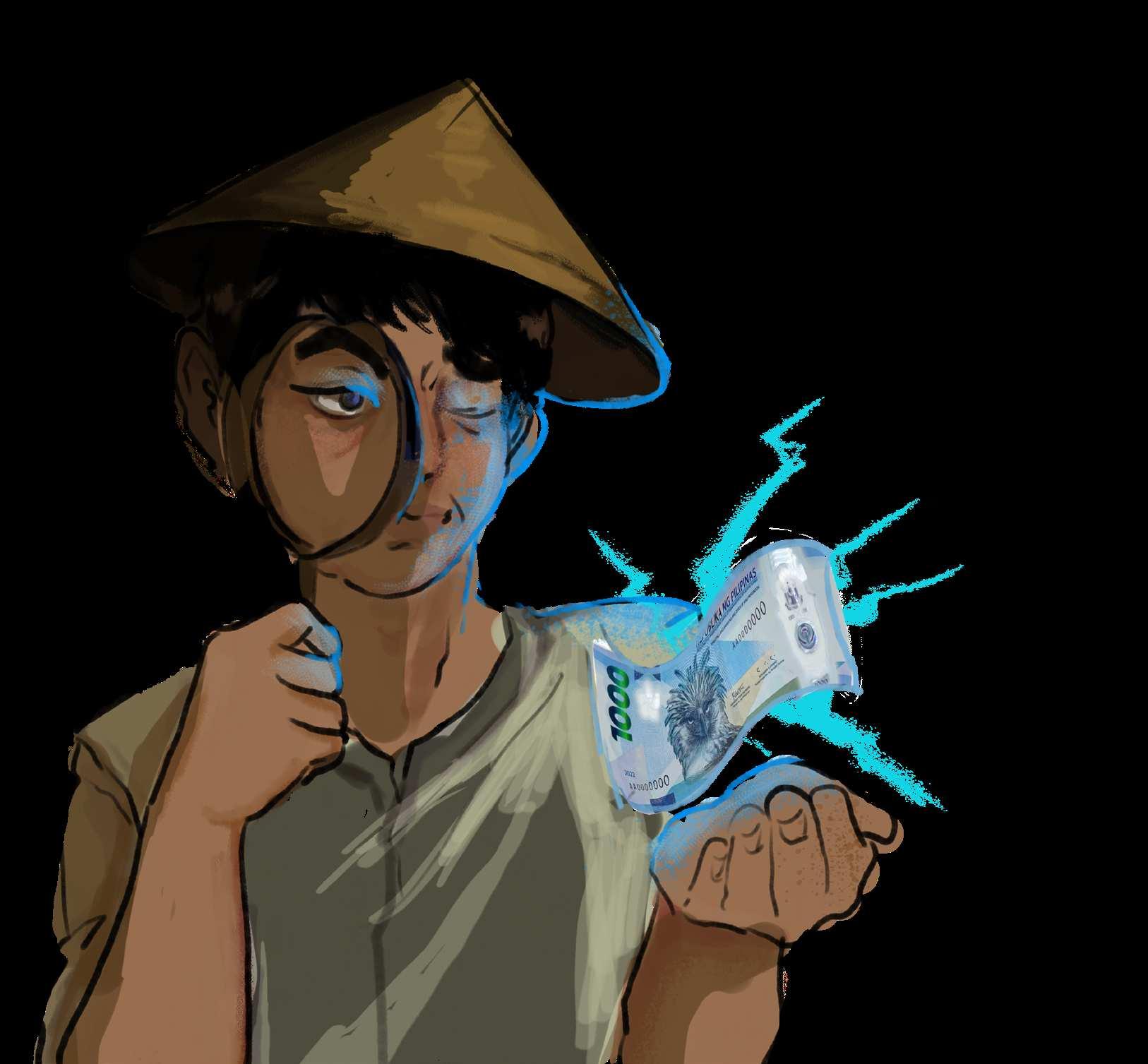


polymer banknotes last two to five times longer than the standard paper note. Such costefficiency lowers overall currency printing expenses, contributing to easier fiscal and monetary management.
Beyond that, security is another edge. As reflected in BSP reports, only 10 cases of counterfeits were reported during the 2-year (2022-2024) period circulation of the 1000piso polymer banknote. In comparison, the 1000-piso paper banknotes have documented counterfeits that shoot off to approximately 98,316 cases out of
As society evolves, so do the symbols and representations that demonstrate the government’s efforts in actively promoting heritage and biodiversity whilst considering the practical benefits that outweigh its cons. Is it not embedded in our Filipino values and national identity to accept change as a means of resiliency? Regardless of our position amidst public discourse, let us encourage one another not to fall into the pits of cynicism and hesitance for a brighter future
In embracing progress, perhaps wearing glasses to see is not such a bad idea. Sure, it is a sign that we are impaired; yet, it is also a sign that we are aware.
Food security has become a major national concern in recent months. Declaring a food security emergency is a daring recognition of the current situation, emphasizing how urgent it is to address issues in the food sector. The now-famous pledge of P20 per kilogram of rice, which increasingly seems like empty rhetoric, is contrasted with this disparity.
Is the declaration a genuine attempt to alleviate hunger, or is it another form of lip service designed to placate public outcry?
Millions of Filipinos facing rising inflation and declining purchasing power found optimism in the promise of P20 rice, which served as a rallying cry during political elections. However, the promise of P20-per-kilo rice has not materialized, and instead, food security has worsened. This reveals a discrepancy between the promises made during campaigns and the actions taken by leaders. It raises concerns about whether such promises are made with genuine intent or as a political lip service. An essential first step in acknowledging the scope of the issue is to declare a food security emergency. Strong policy changes, more funding for agriculture, and a reassessment
of significant dependency are all recommended. But the sharp discrepancy between this announcement and the unmet promise of P20 rice calls into question the sincerity of government programs. Is the declaration a genuine attempt to alleviate hunger, or is it another form of lip service designed to placate public outcry? Even after nearly half of the president’s term, this campaign is still only a “aspiration” and is far from a reality.
The country cannot afford to be influenced by political bluster or hollow promises. The reality of food insecurity is too urgent, too devastating, to be treated as a mere talking point in campaign speeches. The time has come for the government
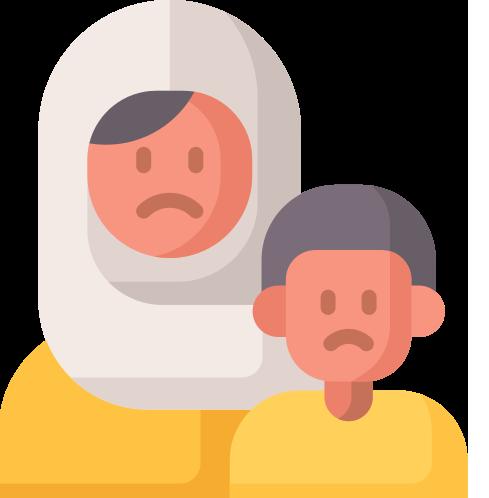
of all large-scale logging projects in the Philippines are within or close to registered
to put aside the spectacle of unfulfilled promises and take decisive action to guarantee food security for all Filipinos.
Securing a future where farmers are empowered and supported, and where our food systems are robust and sustainable is more important than simply advertising P20/ kg rice. We must demand more than mere political rhetoric. We must insist on transparency, accountability, and a sincere commitment to reform.
The struggle for food security is a moral one as much as a political one. We can only close the gap between promises and millions of people’s plates by taking strong action and implementing significant reforms.
SINKING GOLD
by AARON MOLDEZ
Cagayan de Oro City is worryingly steadfast in its plans to become the Philippines’ fourth metropolitan center by 2025, as outlined in its Philippine Development Plan (PDP) 2017-2022. Per the National Economic Development Authority (NEDA), the near future sees the city following in the footsteps of Manila, Cebu, and Davao as economic and administrative cores of the country. For CDOC to stand its ground alongside the nation’s top three, it cannot be without concerns for a future brimful of unmet needs and impending obstacles.
Infrastructure development, for one, has made a significant progress in Cagayan de Oro City–the construction of buildings is concrete evidence that economic movement is present in the slightest. However, as an emerging metropolitan hub, it should go beyond surface-level improvements. In 2023, the Commission on
The Presidential Proclamation 1906, signed in 2009, mandates the “recognition and protection of the rights of Indigenous Cultural Communities (ICC).” Yet, once again, we are opposed by the government’s underlying hypocrisy in its incompetence to oppose landgrabbing acts that have stood the test of time.
For example, the DENR (Department of Environmental and Natural Resources) facilitated the approval for agribusiness corporations to establish oil palm plantations encroaching on Higaonon


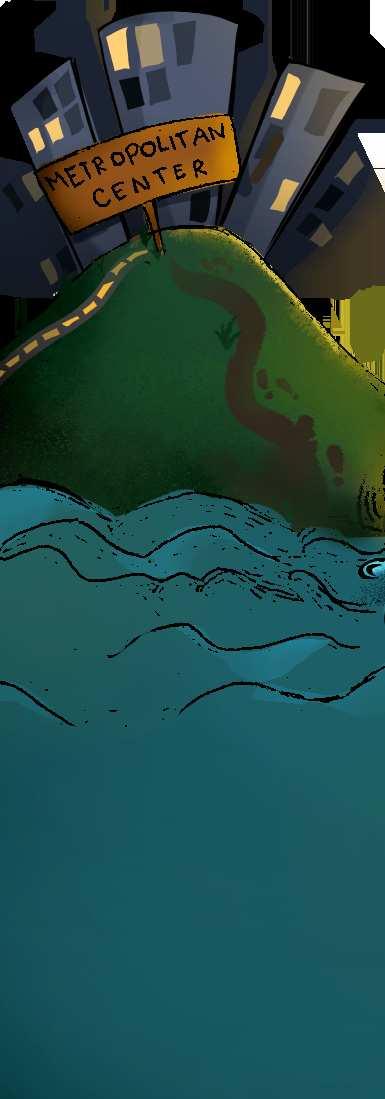
by AARON MOLDEZ
Rooted in the Higaonon hinterlands and tribes of Cagayan de Oro are the mountains of unethical and unwarranted exploitation on their native grounds. Even amid the annual National Indigenous People’s Month celebration every October, the inability of the highest powers to respect those rights remains. What is now left of Indigenous Peoples (IP) are the remnants of forked ancestral lands–a byproduct of the country’s dismissive hands.
ancestral lands. In another case, DPWH (Department of Public Works and Highways) allowed for the development of Route 995, a highway from Villanueva to Gingoog City, to destroy several sacred sites and ancestral burial grounds. Such an exploit betrays the Certificate of Ancestral Domain Title they have held since 2009 and, on a wider scale, the faith IPs put in the agencies that are supposed to support them.
Governing powers tolerate these acts without their free, prior, and informed consent (FPIC). To arrive at such decisions without
acknowledging their approved filing for ancestral domain claims under the Indigenous People’s Rights Act (IPRA) of 1997 is a huge thwart in the name of welfare and cultural rights.
“There is no justice in quenching the thirst for water if it is at the expense of destroying communities,” stated Human Rights Commissioner Gwendolyn Pimentel-Gana on the human rights impacts of the Kaliwa Dam project back in 2019. Following such sugar-coated sentiments, however, are the targeted natives who are currently and still clearly unsatisfied with the system.
Less toleration of displacement and land-grabbing, in general, is necessary to save the IPs of our country on a larger scale. Until then, celebrations and festivities for our IPs are nothing more than facades of what hides beyond the roots. Surpassing the materialism of preserving culture is the extent of honoring the indigenous that the highest powers have yet to reach. Now is not the time to reshape mountains, but rather to reshape the narrative.
December
2024, saw the country’s first-ever polymer banknotes from Bangko Sentral ng Pilipinas (BSP) in a ceremony
At the precipice of all it dreams to be, Cagayan de Oro City (CDOC) teeters on the edge in its push for metro status. With limited infrastructure and frequent flooding, this “City of Gold” struggles to keep its head above troubled waters. Metaphorically and quite literally, the city may be sinking by the weight of its own problems.
by MAICA UYAN
art by VANESSA JADA
72/80
barangays in Cagayan de Oro are susceptible to flooding, according to the Mines and Geosciences Bureau

34,898
households in CDO need to be relocated, including those in high-risk areas near rivers, creeks, and landslide prone areas


enough to protect the lives that witnessed the area’s recent storms. These issues arose following tropical storm Kristine, which displaced people and destroyed numerous homes in Bicol last October 2024. Students, for the most part, will experience the true weight of such circumstances. Floods will actively persist in terrorizing the lives of daily commuters made up of residents and learners alike.
Cagayan de Oro City’s course towards metropolitan greatness is met with, without exaggeration, some of the most challenging tides and waves–a challenge requiring more than just paper boat initiatives. Despite all odds, CDO still has the capabilities of successfully transitioning into a metropolitan center. What it only lacks is a more serious initiative on the office’s part and acknowledging the areas the city is short of. Gold symbolizes more than just Cagayan de Oro City’s potential; it is also built off of the people’s faith in a better tomorrow. We may be sinking, but we have not sunken–a reminder that a rising and successful metropolis is still within reach, despite all odds.
Cagayan de Oro City’s course towards metropolitan greatness is met with, without exaggeration, some of the most challenging tides and waves–a challenge requiring more than just paper boat initiatives.


In textbooks and any social media platforms we learn of the battles, political alliances, and treaties that have shaped modern society. Yet, there is a dark, pervasive silence around the suffering endured by one vulnerable group throughout history: women. In particular, the horrors experienced by Filipina “comfort women” during World War II remain largely absent from mainstream education. This lack of representation is more than an oversight; it’s a profound injustice that perpetuates historical amnesia and denies young people a complete understanding of the past.
Letter to the Editor
Dear Editor,
As we start a new academic year, Nudo Veritas has prevailed with its thirst for impartiality and showcasing stories that matter. Even with the newer trends, Gusa Regional Science High School - X proceeds with the same objectivity to be the voice of the studentry. We may have kicked off from the past year with heavy recognition, but that should never mean that we are writing for laurels. After all, the truth does not come with shining medal.
In every single community, there is a story worth writing, a perspective worth spreading, and the truth worth saving. Every day is one worth writing when the townspeople have voices that deserve to be heeded.
As campus journalists, we bring glory to our institution by winning; not with trophies, but with amplified voices and truthful sentiments.
To the studentry, may we never let any obstacle get in the way of speaking up in the first place. With us being the next generation of leaders, may we fuel the most important aspect in today’s world: truth.
Best Regards, Johnson Tan Grade 11
voxpopuli
At the precipice of all it dreams to be, Cagayan de Oro City (CDOC) teeters on the edge in its push for metro status. With limited infrastructure and frequent flooding, this “City of Gold” struggles to keep its head above troubled waters. Metaphorically and quite literally, the city may be sinking by the weight of its own problems.
The fact that they do not do anything to improve it, says a lot about their incompetent leadership. Its enhancement is very crucial as the Philippines is now more prone to typhoons which will affect many people in our city during floods.
Regala, G10 ORION
Flooding in the city has always been a challenge for me as a student. Imagine going to school dry but leaving soaked and wet. Heavy rains turn roads into rivers, causing delays and discomfort. This not only disrupts our routines but also highlights the need for better urban drainage systems.
Vasallo, G12 ALZONA
Recently, the television primetime series “Pulang Araw” received online praise for including this vital piece of Philippine history; even more so that it has exceeded the education system’s representation on student textbooks. However, it also revealed the general public’s lack of awareness on the plight of comfort women back then. Consequently, House Assistant Minority Leader and Gabriela Partylist Rep. Arlene Brosas heeded the calls to push for the establishment of House Bill 8564, or the Comfort Women Education Act. Filed in June 2023, this bill seeks for the inclusion of the heroic lives of comfort women in the K-12 and Tertiary Curriculum. In light of this, the issue does not only encompass
specific historical events but includes recognizing the systemic atrocities that have targeted women in nearly every conflict. By not addressing these realities, our educational system further implies that even heinous crimes committed against women are silenced and deprive future generations of the oppression we have suffered. The lack of representation of comfort women in education reflects a broader pattern in how the violence inflicted on women in conflict zones is often downplayed or ignored. The silence around such stories creates a distorted history, one that neither honors the sacrifices made by survivors nor encourages students to learn from past atrocities. Those who fought, survived


Crossroads of Faith and Democracy
by SORAINE NOEL
In a country where faith and politics either clash or intertwine, religious organizations influence political matters considerably. While some groups openly endorse candidates, others provide subtle yet evident influence to their members. This relationship between politicians and religious institutions raises important questions about the extent of religious involvement in governance.
A ‘National Peace Rally’ spearheaded by Iglesia ni Cristo (INC) members nationwide gained traction as one of the country’s prime examples of political extremism in religious groups. Though the name on paper suggests pure moral intentions, the event is nothing more than an epitome of our country’s senseless order of the separation of church and state.
Sure, our strong religious identity often intersects with politics, but this should not justify religious institutions’ involvement in electoral decisions. The rally being held as a support system for both President Ferdinand Marcos Jr. and Vice President Sara Duterte along with familiar and notorious officials shows more than enough of their political standpoint. Notable politicians present in the rally held at Quirino Grandstand were Senator Ronald “Bato” dela Rosa and Senator Bong Go.
endorsements of politicians by religious groups challenge the principle of separation of church and state. Article II, Section 6 of the Philippine Constitution explicitly states, “The separation of Church and State shall be inviolable.” This provision intends to keep religious influence out of governmental affairs. No matter how many times the rally is presented as a tool for unity, it blurs the boundary of religion and law, risking the perception that governance is influenced by sectarian interests rather than the will of the people.
involvement in political endorsements
undermines democratic principles by compromising voter independence and election fairness and leads to political extremism. The separation of church and state is vital to maintaining the integrity of elections, and both politicians and religious organizations must respect this boundary to protect the core values of democracy.
Modern occurrences of political extremism must urge policymakers to further stiffen laws governing religious influence in political campaigns. This clear boundary between faith and governance eradicates the risk
No matter how many times the rally is presented as a tool for unity, it blurs the boundary of religion and law, risking the perception that governance is influenced

and defended their dignity should be remembered, serving as a powerful educational tool for empathy and ethical reflection as well. Educational reform, supported by consistent and respectful media representation, could finally bring justice to comfort women by making their stories an essential part of history, rather than a footnote. Media and education hold a shared responsibility to ensure that future generations understand the full scope of wartime suffering, not just for accuracy but for humanity. This recognition is the first step toward healing and justice for survivors, their families, and society at large.
The lack of representation of comfort women in education reflects a broader pattern in how the violence inflicted on women in conflict zones is often downplayed or ignored.

religiousextremes
shadowsofpinkishcourage
by MAICA UYAN
source: UN Habitat Philippines
art by NOVIE ASAS & colored by VANESSA PINTOR
art by GABRIOLA HAMAINE

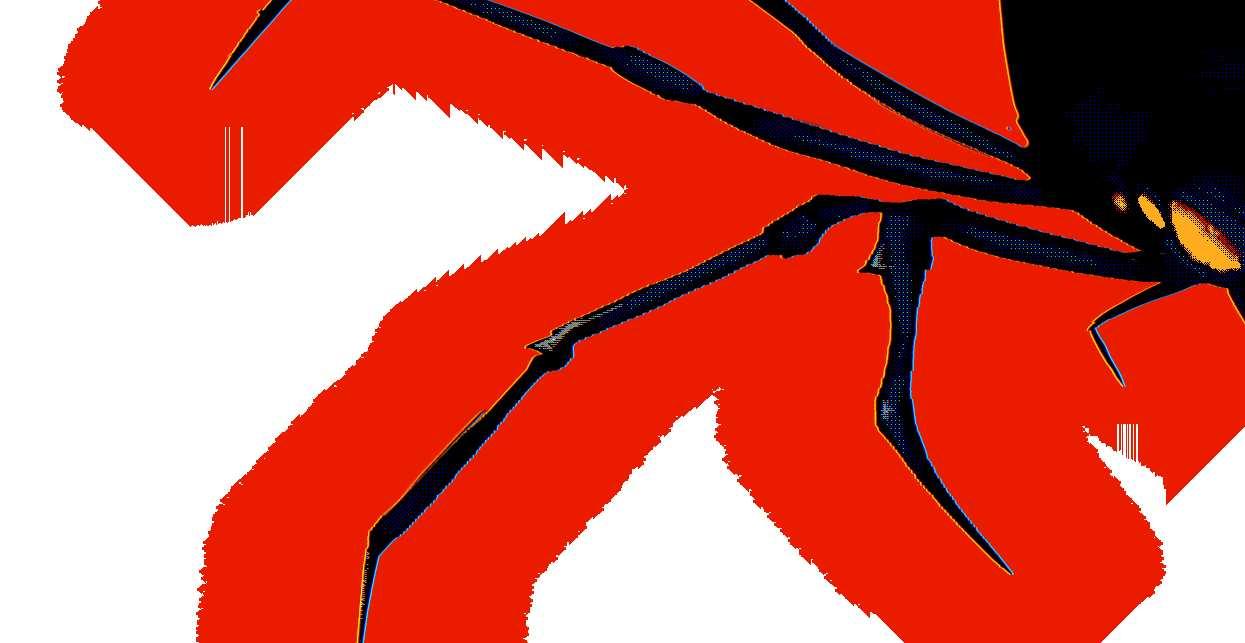
Silk Threads Lasting Mark
by DANAE ORDOYO
Silk
threads
of
exploitation may be difficult to see, but with collective effort, they can be dismantled in order to provide the courage for all victims to

“One day, as I was walking through the city proper, someone suddenly approached me, spouting offers for quick money-making jobs. They moved in uncomfortably close, and a wave of helplessness washed over me—I had no idea how to escape the situation,”
Iz (a code name to protect the victim’s identity) recounted, her face stricken with fear. Traffickers, like spiders, lurk and wait for the right moment. Once they sense the victim has let their guard down, they strike swiftly, injecting a sense of dread and confusion. Just as a fly entangled in a web becomes disoriented and fearful, the victim, gripped by panic, loses the ability to think clearly or escape. This was
anything worse could happen, their grandmother noticed and intervened just in time. Like Lia’s experience, many human trafficking cases reveal that traffickers often start by enticing the victims with material gifts and tricking them into following them.
Given the age range of those targeted, many victims may not fully grasp the consequences of yielding to a trafficker’s words. This is why offers of quick rewards can easily draw them in. Gradually, the trafficker begins to wrap the victim in invisible threads, tightening their hold and rendering them powerless. Once fully ensnared in those delicate strands, the victim’s will is no longer their own—they are trapped, forced
The impact of human trafficking extends far beyond physical freedom. Even after escape, survivors find themselves ensnared in a labyrinth of invisible threads— emotional scars, traumatic memories, and fears—that continue to hold them back, sometimes for years. Iz and Lia both expressed how deeply the experience affected them, leaving them vulnerable to flashbacks even within the supposed safety of their own homes. For Iz, however, any situation that remotely resembles her ordeal can trigger intense anxiety, pulling her mind back to those dark moments and creating the sense of being ensnared in a web that never truly disappears.
support to help cut through the web of trauma that remains long after physical escape. Survivors face the arduous task of untangling the remnants of their captivity—threads of fear, shame, and anxiety that can take years to unravel. But with resilience, support, and understanding, they can rebuild their lives, slowly but surely reclaiming the strength and freedom they were once denied. Each victim’s story is one of survival, but also of hope. It underscores the importance of awareness, vigilance, and compassion in the fight against human trafficking, reminding us all that the silk threads of exploitation may be difficult to see, but with








Reaching Through the Web
by DANAE ORDOYO
Even after escaping the tight grip of the silken threads, victims are haunted by invisible strands that leave them vulnerable and paranoid. Similarly, their families are ensnared in the web of helplessness, reaching out through the suffocating darkness, unable to fully protect their loved ones. Caught in the same threads of fear and despair, both victim and family face an ongoing struggle to untangle the trauma.
Despite being caught in the same web of fear and uncertainty, families often fight the hardest to help their loved ones break free. They offer the strength and resilience needed for healing to begin. The journey of recovery, though painful, is never a solitary one. It’s through the love and dedication of those who refuse to be consumed by the web that survivors can start to rebuild their lives..
In the first moments of Iz and Lia’s journey through healing , the steady presence of their families became a powerful anchor, grounding them in reality and offering a constant reminder that they had truly escaped the trafficker’s web. This unwavering support helped restore their sense of safety, allowing them to take the first steps toward reclaiming their lives.
parents acknowledge that, while they cannot turn back time to prevent her entanglement in the web, they can help rewrite her experiences with positive, healing memories. To free her from the grip of those lingering invisible threads, they organize simple gatherings in order to talk, laugh, and reconnect, allowing her to feel safe and at ease once more.And whenever those silken threads resurface, threatening to engulf her in darkness again, they try to be there for her as much as possible.
“As a family, we tried to deal with the trauma by focusing on positive activities, like going on trips together. It was a way to help us all get our minds off the incident and create new, happier memories,” Jul—Lia’s brother— expressed. He emphasized that these trips not only helped the family bond but also provided a secure, supportive environment in which his sister could begin to heal.
offer victims a sense of lightness, easing the weight of their trauma and providing moments of relief as they begin to rebuild a sense of normalcy.
Though things may eventually return to a sense of normalcy, many things will inevitably change, especially the dynamics of relationships and the emotional well-being of the family over time. As mentioned, this experience has brought families closer together, fostering a deeper appreciation for the safety and togetherness they now share. In addition, it has underscored the importance of staying vigilant to the dangers around them and always looking out for one another.
“For me personally, it made me more cautious and more empathetic to situations involving trauma. I became more aware of how easily things can change, and how important it is to support each other during difficult times,” said Jul. This highlights how trauma should
silken threads may never fully loosen, but through the constant presence of their families, the weight of those threads becomes easier to bear.
Not only that, their experience became a beacon of light, shining awareness on the countless webs of human trafficking that often go unnoticed. Jul emphasized the harsh reality that these encounters happen far too frequently and stressed the importance of recognizing the signs and understanding the risks involved.
In addition, Jul expresses a deep hope that no one, especially children, should ever have to fo through what his sister and their family went through. He believes that if their story can even slightly illuminate the darkness traffickers impose on their victims, then it is worth sharing.
Ultimately, their traumatic experience is not something that can be easily undone or forgotten. It leaves an indelible
“
In the end, healing from trauma is never something one does alone. It’s a journey that unfolds with the support of those who care—family, friends, loved




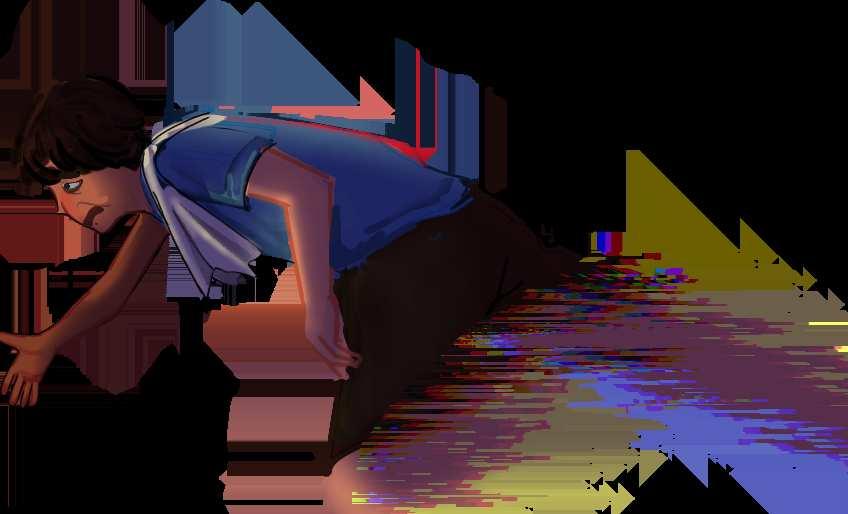

Memories in the Mundane
Fast fashion might be a booming $150.82 billion industry, but no price tag can ever match the sentimental value of the trivial items we cling to. Sure, the aesthetic appeal draws us in, but why do we treasure something as mundane as a bus ticket as if it were a rare artifact from a bygone era?
Anik-anik. A Filipino term to excuse the attachment issues we possessed. These are trivial items that can be a variety of things; stickers, cards, or a candy wrapper from all those years ago with a flashy pink


The Escape That Traps You That
by DANAE ORDOYO
It starts innocently enough— a little It a little escape from the chaos of everyday life. the chaos of At first, it’s comforting to lose yourself in At it’s to lose yourself in this world that demands nothing but your this attention. But over time, the lines blur. What attention. But What was once a harmless distraction becomes a black hole, pulling you deeper until it feels like black deeper until it feels like there s no way out The escape you sought there’s no way out. The escape you has become a trap, holding your thoughts has become a hostage and leaving you stuck in a cycle you you stuck never meant to enter enter.

bythenumbers Anik-anik Industry in GRSHS-X
A survey conducted by Nudo Veritas revealed that
8 out of 10 students enjoyed collecting Anik-aniks as part of the decoration in their bags, among others.
TOP5Reasonsforthisenjoyement Pleasure CulturalInfluence Confidence Stress Relief Exploration
us feeling like spectators to our own decline. The constant stimulation from social media and bingewatching creates a cycle that’s hard to break, as if our brains crave instant gratification even though it is in the process of ‘rotting’. Though it may seem like the escape we sought has trapped us, there is hope for breaking free. Acknowledging that we are caught in this cycle is the first step toward regaining control. By setting limits on screen time, prioritizing activities that engage the mind without overstimulation, and focusing on realworld connections, we can shift the balance. Technology doesn’t have to be the trap— it’s about finding harmony between escape and awareness. With intentional effort, we can enjoy the benefits of entertainment without allowing it to consume us. The key is taking back control, ensuring the escape doesn’t become the prison.

Unearthing Relics That Shape Our World
No students, no pages turning–just silence. After that? Swipes, scrolls, and clicks. The living relics that represent today’s 21st-century libraries are now lost to time in a world of advanced technology, where information can instantly be accessed at a moment’s notice.
Originally bustling ruins known to carry bookshelves of wisdom and knowledge passed down from generation to generation, are now empty hollows echoing the footsteps of students who dare tread upon these ancient grounds. This is the sad truth behind our libraries, if not, the traditional modalities of our past.
Public libraries are experiencing a huge decline in the modern age, mirroring international studies, as indicated by the UKSG (United Kingdom Serials Group) report on the impact of library discovery technologies. The research reported that most students would only go to the library if they could not find what they needed on search engines like Google, Bing, and the like. Such data echoes related trends seen in the Philippines. According to a 2019 research journal by the PAARL (Philippine Association of Academic/ Research Librarians), undergraduates favored online materials over traditional library collections to gather information and data.
Embracing new technological norms meant trading the once-wielded excavation tools by archaeologists and students alike for more cuttingedge devices. This is seen through the words of alias Nal, a third-year student working on her research paper, who states, “I prefer to gather information from online sources since it’s easier and quicker to obtain facts. I find it a hassle to visit a library to gather information since the travel is time-consuming—I could already search for information on the web during this timeframe. As a student, I don’t have the luxury of time to go to a library to find resources when I have an easier option at hand.”
And yet, crevices of hope in a yellow light pierce through the piles of rubbles that are technological breakthroughs. By sheer influence alone, libraries glow through the power of impact, continuing to hold their own as endurant providers of firsthand material.
Upon exploration, libraries of the 21st century have more purpose than
they appear on the surface; much like artifacts, it takes a keen eye to unearth their true meaning. In the context of significance, these libraries serve as hotspots for accessible material, an important factor to consider in regions where access to information online is limited.
A 2023 report by the National Library of the Philippines (NLP), on the status of Philippine public libraries & librarianship further emphasized such significance, stating that, “Public libraries are relevant despite the active entry and use of computer and internet technologies in the country.” Libraries and ancient relics are both touchstones of wisdom, however: one offers us the treasures of the past, while the other offers us the treasures of the future. Though society continues to move forward, even if it means leaving behind material culture, its role in society is like a treasure chest buried by the foliage of time–seemingly forgotten, but brimming with timeless riches.


Thirst for CHANGE
by TABITHA LAGRIA

de Oro Bulk Water Incorporated (COBI) to make sudden repairs for 2 days. This issue not only affected the grounds of CDO but also the neighboring towns in Misamis Oriental. One of the greatly impacted areas was Opol, leaving families with a sudden burden of havig little to no water for days.
For students like Nella Regasa, a GRSHS-X student and a resident in Opol, the lack of water isn’t just an inconvenience - but a barrier from her education and a normal day-to-day life. “Lisod kayo kay kana bitaw nga magkuha pakag tubig sa uban nga lugar para lang makaligo ug laba, tas kasaban dayon ka skung walay uniform.” She described the intense exhaustion of a daily need being out of reach. Each day, she and her family find efficient ways for them to have a water supply enough to meet their needs. It has now become a part of her routine to become accustomed to the challenges of a limited water supply.
The scarcity, however, continues to persist when it was disclosed that a simple leakage wasn’t just the reason for this colossal problem. The city’s primary water provider, Cagayan de Oro Bulk Water Incorporated (COBI), has shut off the water services in at least 13 towns due to a dispute P479 million debt with the local water authority. This issue, now tangled in legal complications, has left the public involved in the fiasco, with no clear end to this crisis. The once-constant flow of the water has now become a problem that looms over the local’s life like a dark cloud.
Due to their recklessness, families have no choice but to tolerate the struggle of a choice they didn’t make. Tasks that were taken for granted like bathing, cooking, and washing clothes now stand as a reminder of what the city used to be. A struggling mother from Gusa elaborates the hardships her family needs to face as they adjust to a life without water. “Mag bagutbot gyud na akong mga anak nga walay tubig. Labi na kung sayon nga ting i-skwela, lisod gyud kayo i-ligo kay kalit raman gud mawala ang tubig.” She explains how their morning showers are a calculated system of how many buckets of water they can each use. She worries about the impact this will have on her children, wondering if they’ll grow to see water as a luxury instead of a right.
As the crisis drags on, the citizens of Cagayan de Oro and its neighboring towns are left to wonder if normality will come again. What started as a temporary issue has transformed into a significant crisis, with no guarantees of a quick fix. For now, Cagayan de Oro’s residents continue to wait, hope, and adapt, making the best of a challenging situation with their resilience and alliance with the community. Water, once as expected as sunrise, has become a daily quest. For those carrying the heaviest burdens – the children, the elderly, the struggling families – each bucket hauled, each drop rationed, stands as both a testament to their endurance and a plea for change.
Wounded Hands That Heal
by EMICK MANUNGAS
In a world filled with pain, it’s often the wounded who understand the depths of suffering best. They carry their scars not as marks of defeat but as reminders of survival. Among them are the healers—those whose hands, though scarred and trembling from their own battles, extend to mend others. It is an irony, yet a profound truth: brokenness can birth compassion, and even the most shattered souls can hold the power to heal.
One such healer is Roberto Pilapil, a man who has transformed his pain into a profound purpose. For the past seven years, Roberto has walked the bustling streets of Divisoria, Cagayan de Oro City, offering his gift of healing to those in need. Behind his steady hands lies a story of hardship—years of physical and emotional wounds that shaped his journey.
A few years back, he shared that his wife left him with their two children to be with someone else she has been seeing behind his back. Therefore, as a single dad, he clung to whatever job was available at the moment to provide for his family. He continued this cycle until he came to a point wherein he realized that his hands scarred with emotional pain can bring healing to those with physical pain.
With the guidance of his friend, Roberto began to see his hands not only as tools of survival but as instruments of healing. He poured his focus into his newfound craft, using it as a way to rebuild both his life and his sense of purpose. Through his work, he not only supported his children but also found a way to transform his own pain into something meaningful for others.
However, Roberto’s journey as a masseuse was not without challenges, as his background as a single father and the emotional scars of his past often led others to question his abilities and resilience. “Ang mga gapa hilot sa ako kay
magreklamo na pangit akong service tapos ipoint out nila akong background. Ngano lagi daw ko nahimog manghihilot na dapat I should be better since kailangan gyud nako ang kwarta,” He expressed. Despite that, he persevered. He shared that when he feels like his wounded hands are not enough, he draws strength from his unwavering determination and his deep faith in God. Roberto also holds on to a positive mindset, believing that all challenges will eventually pass, and that every struggle he endures is another step toward a better future for himself and his family. He further
emphasized that his two children are his greatest inspiration, a constant source of motivation to keep going no matter how difficult the path may be. “Ang pinakarewarding gyud para sa akoa kay kanang makita nako akong mga anak na malipayon, gaskwela ug makakaon ug tarong,” Roberto said. His story is a testament to resilience and purpose. Despite the scars
he carries, he continues to offer healing to others while drawing strength from his faith, determination, and love for his children. His journey reminds us that healing isn’t about being whole but about rising above hardships to help others rebuild. Through his hands, brokenness becomes a gift—a way to touch lives and mend what seems irreparable.
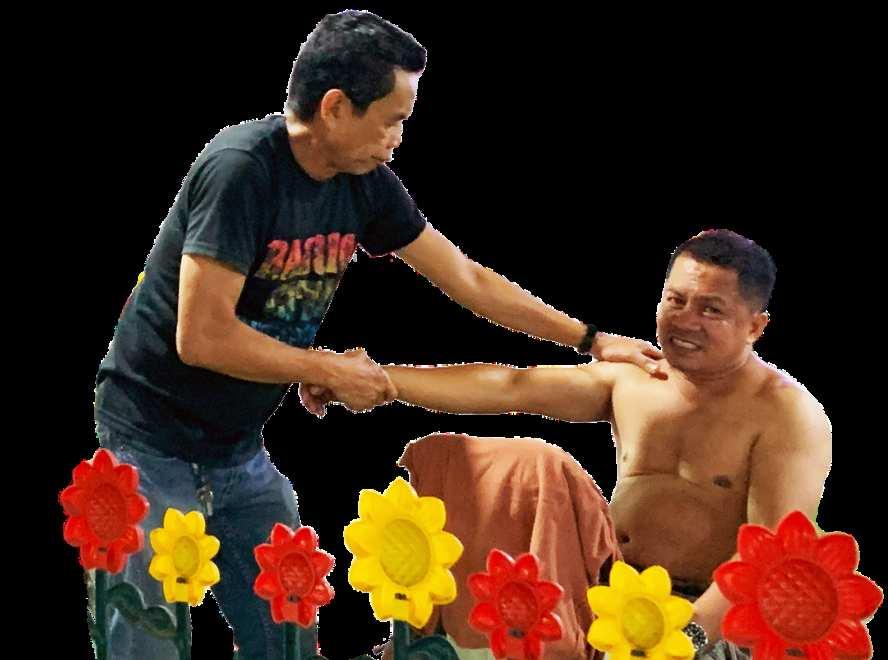
Caught in Congestion:
by SOPHIA YACAPIN

of Cagayan de Oro City’s households have been affected by the water crisis.

“It’s so annoying because I have so many tasks to do in the afternoon. We have modular lessons, and teachers usually give out assignments, but nope—I’m still stuck in traffic!” exclaimed a frustrated senior high school student. Interestingly, the TomTom Traffic Index 2025 ranked Davao City as the 8th most congested city globally, while CDO was not even mentioned. While this might suggest less congestion in CDO, it doesn’t take away from the frustration of daily commuters. On average, a 10-kilometer journey in the city takes about 17.5 minutes—a seemingly short time, but one that feels far too long for students juggling tight schedules.
“My schedule is Set B, so I’m in school from 12:15 PM-ish to 5 PM. During those hours, it’s rush hour, and what should be a 30-minute commute from school to home stretches to an hour because of traffic,” shared a junior high school student. The challenge of navigating rush hour adds to the fatigue of an already packed school day. Another student added, “Especially in areas like Cogon. I just take a nap, and even then, I’m still in the same spot as before.”
by ASHERA TAYRUS
While 17.5 minutes might seem short compared to larger cities, the cumulative impact on students and the community is significant. Sitting in traffic adds to stress and fatigue, taking away precious time that could be spent studying,
resting, or with family. Business owners also feel the pinch, as delays disrupt operations and hurt their bottom line. Emergency services face additional challenges, with critical response times often hampered by clogged roads. The increasing traffic in CDO is tied to several factors, including the rising number of privately owned vehicles, poor road conditions, and inadequate traffic signals. For many families, owning a car or motorcycle is a necessity due to the lack of efficient public transportation. However, this reliance on private vehicles only adds to congestion. Urban development projects and limited planning have also compounded the issue.
Considering these challenges, the saying “Be
part of the solution, not the problem” becomes especially relevant. Students can opt for carpooling with friends, walking, or biking to school. Communities can push for more efficient public transport systems and advocate for better urban planning. Being caught in congestion isn’t just a personal struggle—it’s a shared burden that ripples through the community. Reducing the average 17.5-minute travel time would not only ease commutes but also improve the quality of life for everyone. As such, let us all contribute to reducing that index, working together to overcome this challenge and pave the way for a future where our city’s time, energy, and potential



One-line Lingua
A Deep Dive Into Pop Culture Lingo
by AARON MOLDEZ
They say a little goes a long way, and when it comes to one-liners, there is no doubt about it.All it takes is the words of another—whether that is a politician, a singer, or even a spoken word poet–to spark conversations of love, joy, and hope. Through just mere phrases, they transcend the constricts of context and become a part of the everyday lexicon, echoing long after they are spoken.
“Eyy ka muna eyy!”
A lighthearted expression by Sheena Catacutan, a member of the P-Pop group BINI. Often used in either uplifting or sarcastic tones—though almost always the latter. Scored low on a test? Fell down a flight of stairs? Do not fret—take it from the words of Miss Sheena: Mag eyy ka muna! Eyyy!”
“Your honor, hindi ko na po maalala”
A statement by Alice Guo that was just as confusing as she was during her interrogation over alleged links to illegal POGOs and questions about her true citizenship. Just the perfect excuse to get out of trouble—and probably the best response when you have no answers.
“Lumaki po ako sa farm”
Yet another infamous statement by Alice Guo, living rent-free like termites among frustrated politicians and witty netizens alike. Might not be the best portfolio to show in a job interview, however. Who knew farming skills would come in handy when faced with criminal allegations?
“That was so hot”
A scandalous message stemming from a series of Maris Racal’s private, online chats with Anthony Jennings. Saying it at a spicy food challenge? For sure.
IN BLIND OBEDIENCE
by DANAE ORDOYO
Our country is a nation of faith and community, where leaders are revered as shepherds and followers as their flock. But what happens when the shepherd’s motives are questioned, yet the flock remains steadfast in their loyalty? This blind allegiance, often described as a “sheep-like mentality,” continues to shape Filipino society—most recently exemplified by the rise and fall of figures like Apollo Carreon Quiboloy.
Filipinos are known for their deeprooted religious devotion, often placing blind trust in religious and political leaders. This mindset can be traced to the nation’s colonial past, where obedience to authority was ingrained as a survival mechanism. Over time, this deference evolved into a cultural norm, manifesting in society’s collective behavior.
Quiboloy’s rise exemplifies this phenomenon. Despite being placed on the FBI’s Most Wanted list and facing multiple allegations, many of his followers remain fiercely loyal, unwilling to question his actions. To them, Quiboloy is their shepherd—his word, law; his image, divine. This loyalty, however, mirrors the vulnerability of sheep who rely solely on their shepherd to guide them, even when that guidance leads to harm.
When Antonio Montalvan II, a
continued to defend who he believed was the appointed son of God. “We will protect him with our lives,” the man stated. That was when Antonio and his companions realized he was a damaged man, made to obey a man who dumbed him down with a promise of a better life.
Antonio shared that the man explained how Quiboloy facilitated his family’s migration to Europe and bankrolled all the expenses for their trip. This might seem generous, but it was a way for him to herd some sheep to expand his flock further. Once they settled in the foreign land, they had to produce a series of daily quotas to pay back the ‘goodness’ of Quiboloy. This situation highlighted how sheep begin to blindly obey their shepherd, entrusting him to lead the way, only to find themselves in a state of servitude masked as gratitude.

The dangers of this mentality extend beyond the Quiboloy case. When society fails to question authority, it enables
corruption, abuse, and manipulation. Leaders are emboldened to exploit their positions, knowing their flock will defend them regardless of the truth.
Quiboloy is not an isolated case. From political dynasties to other controversial religious leaders, the Philippines has seen countless shepherds lead their flocks astray. The consequences are felt on both personal and national levels, with families torn apart and institutions weakened by misplaced trust. The sheep-like mentality, while rooted in cultural and historical context, need not define the Filipino people. Quiboloy’s story serves as both a cautionary tale and a call to action. The time has come for the flock to look beyond the shepherd and toward the truth—because blind loyalty leads only to a precipice, and the Philippines deserves better than to be led astray.
800,000-1M

tourists visit Palawan annually, with El Nido being the hot spot for the
A Crown’s Luster, A Community’s Pain
by DANAE ORDOYO
he Golden South Sea Pearl Crown is a breathtaking symbol of elegance, wealth, and global beauty. Adorned with luminous pearls sourced from the pristine waters of Palawan, it represents the Philippines’ rich natural resources and craftsmanship. However, beneath its gleam lies a lesser-known story of struggle and gentrification—a story that traces back to the indigenous communities of Palawan, who continue to bear the hidden costs of this radiant crown.
For years, Palawan has been dubbed a paradise for both locals and tourists. Its crystal blue waters and white sands radiate with an air of relaxation. Beyond its natural beauty, the abundance of pearls found beneath the sea is another reason why the masses are drawn to the island. Yet, this allure has masked a deeper story of displacement, environmental degradation, and gentrification.
“A few years ago, I was assigned to Balabac to lead the implementation of a Japanese government-funded conservation and poverty alleviation program in this southernmost municipality
The indigenous Palaw’an and Molbog peoples of Southern Palawan, particularly in Balabac, have faced decades of displacement. Land reforms and the expansion of industrial operations, such as those by Jewelmer, have disrupted their traditional livelihoods and access to ancestral territories. These communities continue to fight for the recognition of their land rights, as their ancestral waters and lands are increasingly restricted and exploited. Furthermore, part of the ancestral lands and beach sides have fallen victim to rampant
“I was confused because the floating hut was visible, signaling that we were within the area, yet the clear waters of my childhood were gone. In their place, a murky expanse concealed the corals and fish beneath,” said Sara Dalabajan, a Palaweño writer from Rappler, expressing how distant and altered the Palawan of her memories had become.
This highlights the profound impact of gentrification on a natural wonder. Beyond the environmental damage it causes, it disrupts the lives of locals.
Many express concerns about how everything is now tailored to meet
overshadowed by the demands of the tourism industry. The Golden South Sea Pearl Crown, while a symbol of beauty and wealth, casts a shadow over the indigenous communities of Palawan, who bear the costs of this radiance. As the pearl industry and gentrification reshape the region, the displacement and struggles of the local peoples cannot be ignored. To truly appreciate the luster of Palawan, we must also acknowledge the sacrifices made by its original inhabitants—who continue to fight for their land, livelihoods, and the preservation of their culture amidst growing



source: Philippine News Agency
new arrivals.
I Ruling the Seed of Doubts
by JILLIANA MICLAT
n the Philippines, a nation known for its agricultural strength, genetically modified (GM) crops like golden rice and BT eggplant are hailed as a solution to malnutrition and food insecurity. While some see promise, the emergence of these biotechnological advancements has become a contentious issue in Philippine courts, raising concerns that the potential benefits of these crops draw a fine line between corporate science and sustainable ecological approaches.
According to the International Rice Research Institute (IRRI) and the Philippines Rice Research Institute (PhilRice), Golden Rice, locally known as Malusog Rice, is a genetically engineered variety designed to address vitamin A deficiency. It contains beta-carotene, a nutrient absent in ordinary rice grains, crucial for maintaining healthy skin, bolstering the immune system, and sustaining vision.
referred to as Bt brinjal, represents another biotechnological innovation to enhance crop resilience. Engineered to produce a protein called cry1-Ac, derived from the soil bacterium Bacillus thuringiensis, Bt eggplant’s vital purpose is to combat the eggplant fruit and shoot borer (EFSB)., a prevalent pest across Asia. GMOs on Trial
was one of the first countries to grant commercial authorisation for Golden Rice and Bt Eggplant in 2021, the Supreme Court issued a Writ of Kalikasan to halt the release of genetically modified crops, ordering the Department of Agriculture, the Department of Health, and other government agencies to halt distribution.
of proof to government agencies promoting genetically modified organisms (GMOs), requiring them to demonstrate safety before commercialization. Critics argue for considering long-term environmental impacts, while proponents claim established safety through equivalence with traditional crops.


opponents, including Greenpeace and MASIPAG (association of farmers).
Furthermore, the court halted the commercial distribution of GM Golden Rice and Bt eggplant due to differing scientific viewpoints and uncertainty regarding their hazards and impacts, which could endanger public health and the environment. Wilhelmina Pelegrina, a Greenpeace Southeast Asian campaigner,


The Court of Appeals’ ruling demands a balance between scientific evidence in technological advancements and environmental sustainability. This mandates a thorough reevaluation of risk assessments underpinned by utmost transparency. Only through such measures can we integrate these advancements with sustainable agricultural practices and achieve a future where the welfare of Filipinos
Above the Davao Scare by
NEEKA GUILLERO
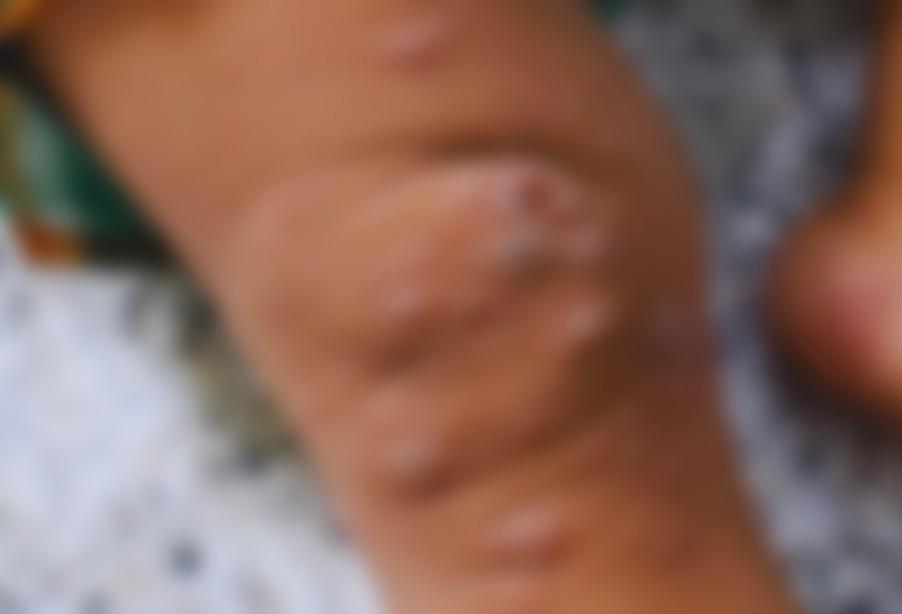

into the minds of people across the nation as well. For many, the virus had seemed like a distant concern, a headline from another part of the world. Now, it has arrived at our doorstep, and the question isn’t just how it got here, but how we can protect ourselves and our loved ones.
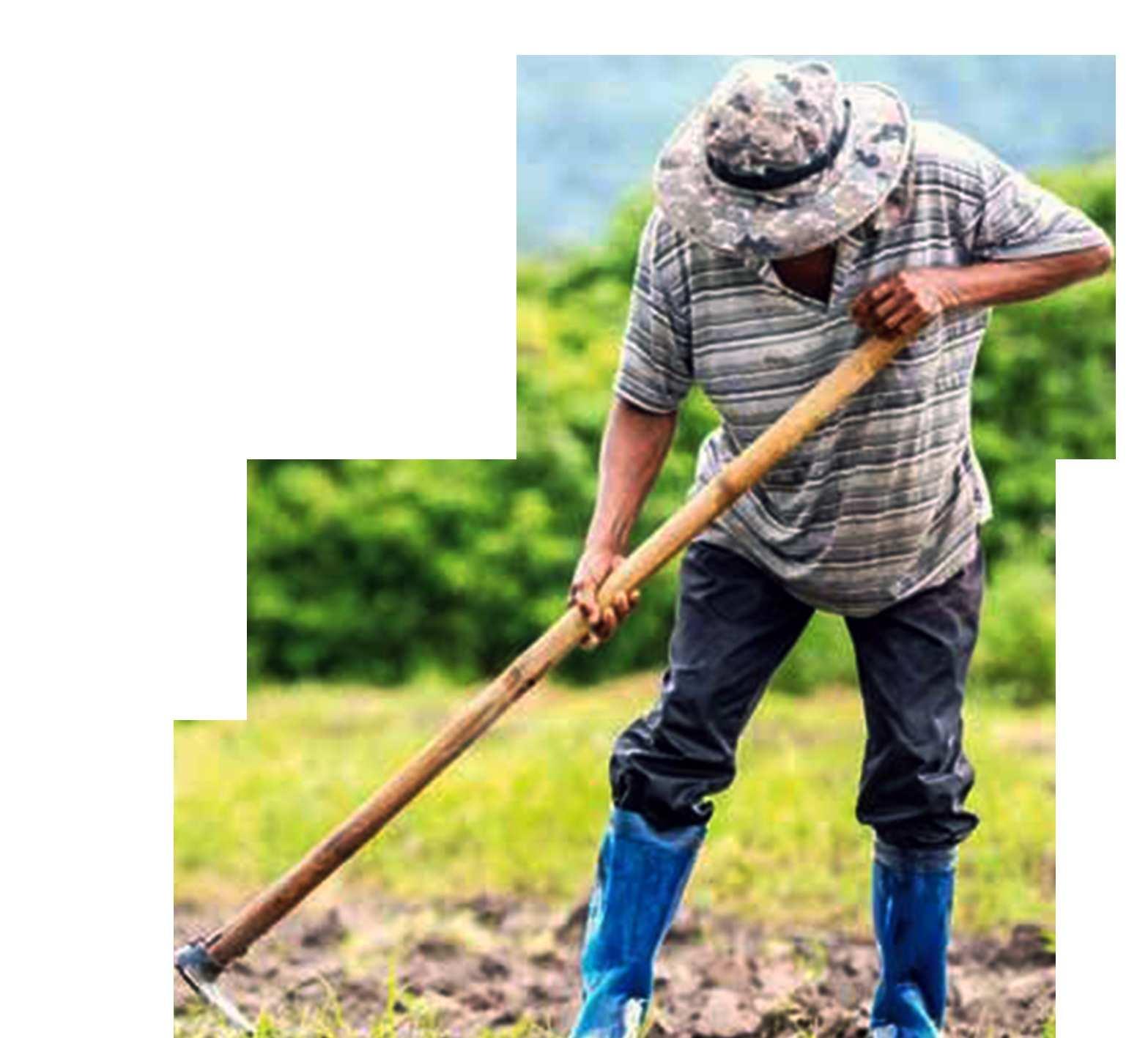
Unmasking Mpox Mpox, a zoonotic virus from the Orthopoxvirus family, is no stranger to global health experts. Though related to smallpox, its symptoms—fever, swollen lymph nodes, and a distinct blistering rash—are generally milder according to the World Health Organization(WHO). In the Philippines, the cases have been identified as Clade II, a variant considered less severe, but that offers little comfort to a community grappling with its sudden appearance.
The virus doesn’t rush—it lingers.
Symptoms may take up to 21 days after exposure to emerge, leaving a wide window for potential spread. According to DOH, symptoms such as fever, headache, muscle aches, back pain, low energy, and swollen lymph nodes typically last two to four weeks. But how does it make its move?
The Silent Spread Mpox relies on close contact to leap from one person to the next. It is not a virus that shouts its arrival; it whispers through touch and proximity: Skin-to-Skin contact, contaminated objects, and respiratory droplets. In Davao, health officials urge caregivers and healthcare workers to don their armor—personal protective equipment (PPE)—and remain vigilant.
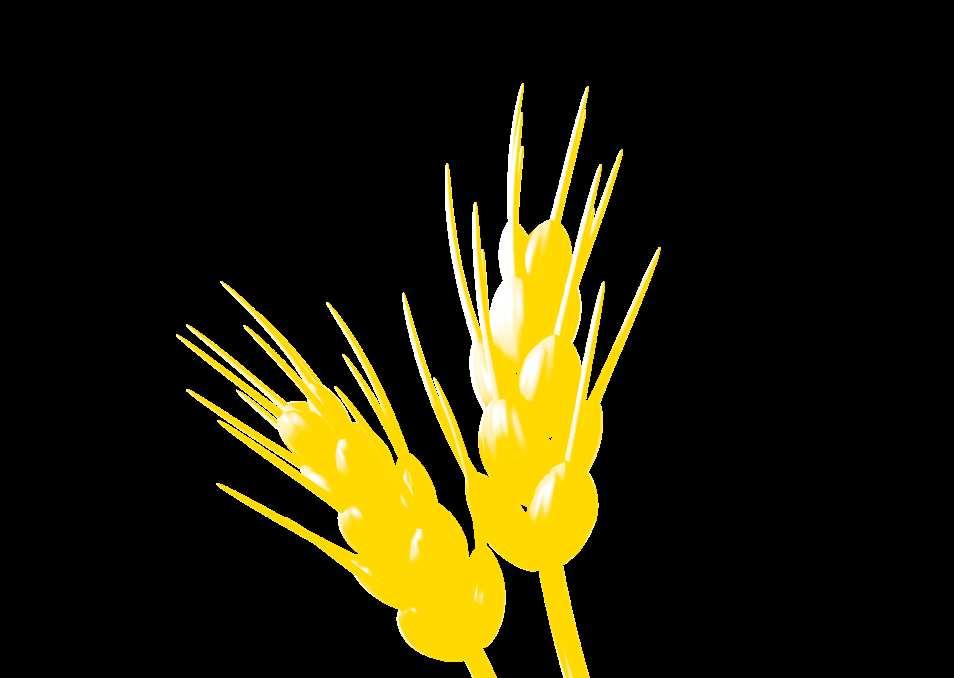


Summer season kicks off, and the sweltering heat creeps onto our skins. With the scorching sun blazing at us, some might think “Sunscreen na ang bahala ani,” (Sunscreen will take care of this.) but the hidden d extreme heat would have gone unnoticed, until the disaster strikes. The nation faces a significant he marked increase in heat-induced illnesses. With heat indices soaring to dangerous levels, public hea raising alarms about the risks associated with prolonged exposure to extreme heat.
The Philippine Atmospheric, Geophysical, and Astronomical Services Administration (PAGASA) has warned the public about dangerous heat indices ranging from 42°C to 51°C, which can lead to health issues such as heat cramps, heat exhaustion, and heat stroke. From January 1 to April 29, 2024, the Department of Health (DOH) documented 77 instances of heat-related illnesses, including seven deaths. It is particularly noteworthy that 67 of these cases involved individuals between the ages of 12 and 21, underscoring the heightened vulnerability of younger people to extreme heat conditions.
Health Secretary Teodoro Herbosa emphasized the severity of the situation, stating, “Older adults, young children, and those with illnesses are especially vulnerable. Make sure they are not exposed to hot environments.”

The extreme temperatures have not only affected public health but have also caused disruptions in the education sector. The Department of Education (DepEd) shifted the school year to take place from August to May partially in response to the COVID-19 pandemic, but this change has resulted in a greater exposure to intense heat during the summer months when classes are running. In response to the rising temperatures and the impact on student health, DepEd has decided to revert to the traditional academic calendar running from June to March, starting on June 16, 2025. This adjustment aims to ensure that classes do not occur during the hottest periods of the dry season, which typically occur in April and May. Hernani Escullar Jr., the information officer for DepEd Region 6, stated, “This decision reflects the increasing requests


from our stakeholders to refrain from holding classes during the peak of the dry season,” underscoring the unbearable classroom conditions faced in April and May. This decision is prompted by escalating worries about the safety of students who dealt with heat-related stress during the peak of last year’s El Niño phenomenon. DepEd has documented cases of students experiencing hyperventilation, dizziness, and fainting due to the extreme classroom temperatures. The alarming rise in heatinduced illnesses has served as a wake-up call for both public health and education sectors. The documented cases of heat-related emergencies, most of which affects students, has become a clear threat that poses serious risks. Avoiding the hottest months of April and May, this calendar shift aims not
As of April 2025, Davao City has recorded two confirmed cases, one of which ended fatally due to severe pre-existing health conditions. While the identified Clade II variant is less severe, the tragedy underscores that vulnerability lies not in the virus alone, but in the health of its host. Authorities are tracing contacts and rolling out protocols, but they face a delicate balancing act: stopping the spread while keeping the public calm.
Despite the slow spread of the virus, the nation must stay vigilant in keeping their families and themselves and healthy at all costs. A reminder for all to take a pause and to “STOP”: Survey Symptoms like fever or rashes, Take Hygiene Seriously by washing hands daily, Omit Close Contact to avoid exposure, and Proceed to a Doctor promptly for early care.
Viruses like this remind us of the fragility of our interconnected world. One case becomes two, and suddenly, a community must confront a new reality. But this is not a story of helplessness—it is one of resilience. As Davao City grapples with its first brush with Mpox, it is clear that our best tools are simple but powerful: awareness, preparedness, and solidarity. This is not just about facing mpox—it is about learning how to face any challenge that comes our way.

THE“OTHERING” OF INNOVATION
by JILLIANA MICLAT
Science continues to evolve at a rapid pace, and at the center of this transformation is Artificial Intelligence. AI is no longer just a futuristic concept, but a present-day reality reshaping the industries across the board. In healthcare, AI is already a proven game-changer in the world. It enhanced diagnostics, streamlined workflows, and made medical research more accessible and efficient.
For the Philippines, the question is no longer if we should utilize AI in healthcare, but how we should use it—-ethically, responsibly, and effectively.
The Philippine Association of Medical Journal Editors (PAMJE) thinks that AI has a transformative role in medical research writing and can be a tool to another medical breakthrough.
We must use all available tools such as AI to increase accessibility of research results
The PAMJE Educational Forum and General Assembly, that took place on March 17,2025, was held as a part of the Department of Science and Technology - Philippine Council for Health and Development’s (DOST-PCHRD) 43rd Anniversary, bannering with the theme, “Building a Healthier and Wealthier Future: Advancing Research Utilization for Greater Impact.” PAMJE sparked discussions on the possible role of AI in the field of medicine research.
“We must use all available tools such as AI to increase accessibility of research results,” DOST-PCHRD Executive Director


Dr. Jaime Montoya said as he shared his insights on the potential of AI further enhancing research writing. While the potential is there, researchers and editors must be equipped with AI literacy in order to fully harness the benefits of using it, without violating AI Ethics. The piled up controversies surrounding artificial intelligence gives experts their own personal and factual insights to guide AI users. Progressively, some hospitals in the Philippines are taking initiative, stepping into the world of AI to find more solutions to impending problems and lifethreatening diseases.
The Medical City, the largest healthcare network in the country, has integrated artificial intelligence in their workspace system. Beginning this year, the Philippine hospital chain has incorporated AI technologies into its mammography and chest X-ray services, and is currently developing AI applications for interpreting 2D echocardiography and laboratory results in predictive medicine.
The goal is to utilize artificial intelligence in a way that benefits society. We must embrace AI’s power, not as a replacement for human ingenuity, but as a tool wielded responsibly, ethically, and with the necessary AI literacy to build a future where innovation thrives, not in isolation,
WickedScience DEFYING GRAVITY FOR A GREENER TOMORROW
Like Elphaba in ‘Wicked’, science is often misunderstood—pushing boundaries, challenging norms, and rewriting what we believe is possible. From uncovering cancer-fighting compounds in the depths of the sea to exploring the promises and pitfalls of AI-generated art, young innovators are proving that the most unconventional ideas can spark the greatest change. Whether it’s harnessing AI to build a more connected digital world or navigating the ethics of its growing power, these trailblazers are stepping up, defying expectations, and proving that the future isn’t written in stone—it’s waiting to be reimagined.
by NEEKA GUILLERO
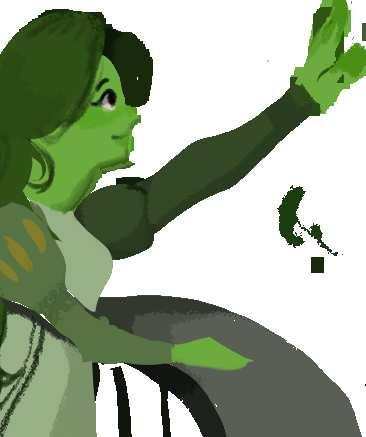
bythenumbers
61,000 metric tons of solid waste—24% of which is plastic. This staggering figure highlights the urgent need for sustainable waste management solutions, including radiation technology for recycling.
(DOST) v
As humanity’s drive and passion As drive and passion transform what were once mere imaginations into realities br once into realities brought about by technological advancement advancements, an ethical line slowly dissipates in the cloud of tr in the cloud of trends and the rush of progres progress.

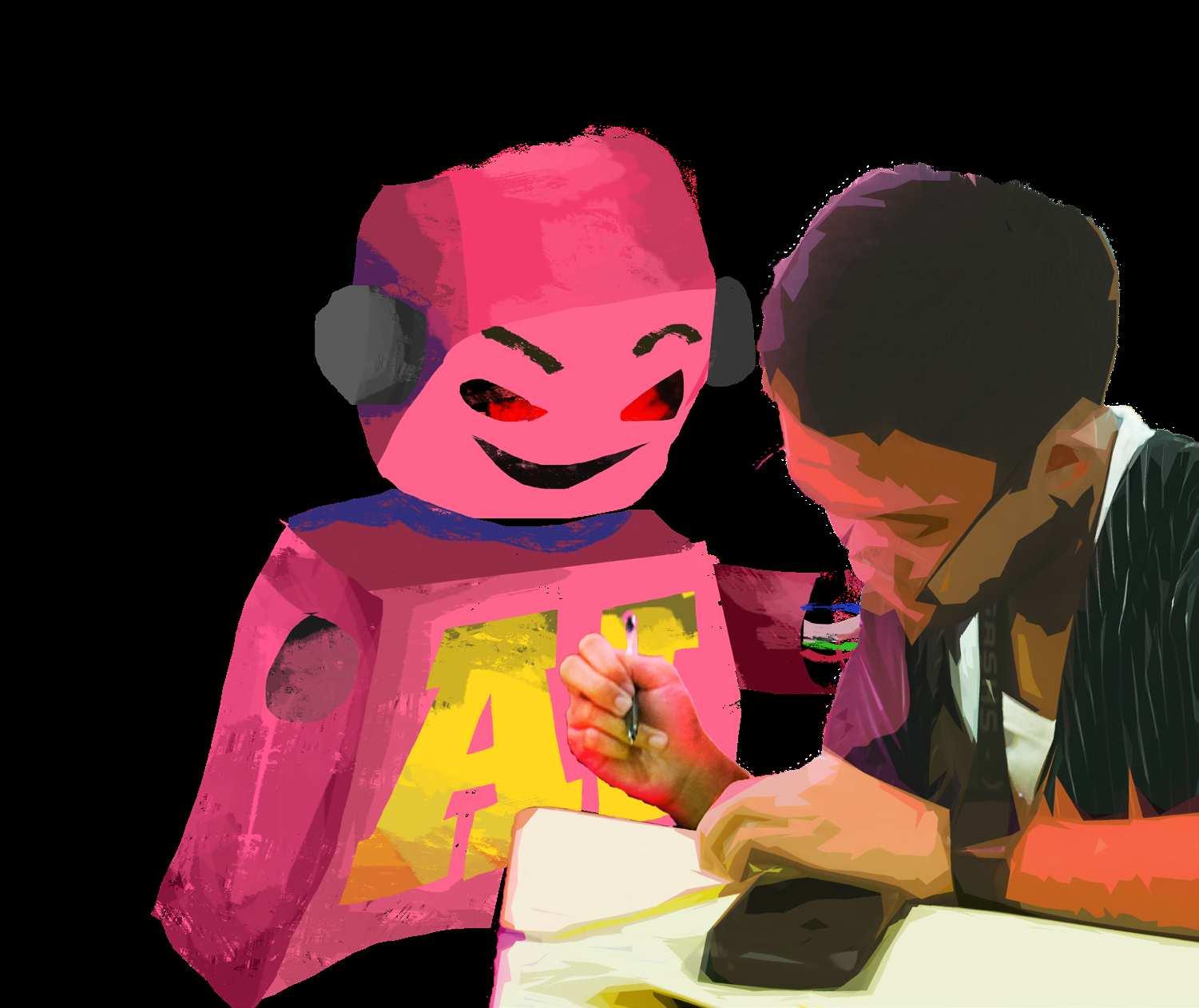

Dr. Jaime Montoya, DOST-PCHRD Executive Director
Art by VANESSA PINTOR
Plastic Peril: PH Among Top Ocean Plastic Polluters
Carlo Arcilla, the Director of the Philippine Nuclear Research Institute (PNRI) under the Department of Science and Technology (DOST), reports that every day, the Philippines generates
by JILLIANA MICLAT
SIGNAL OF CHANGE
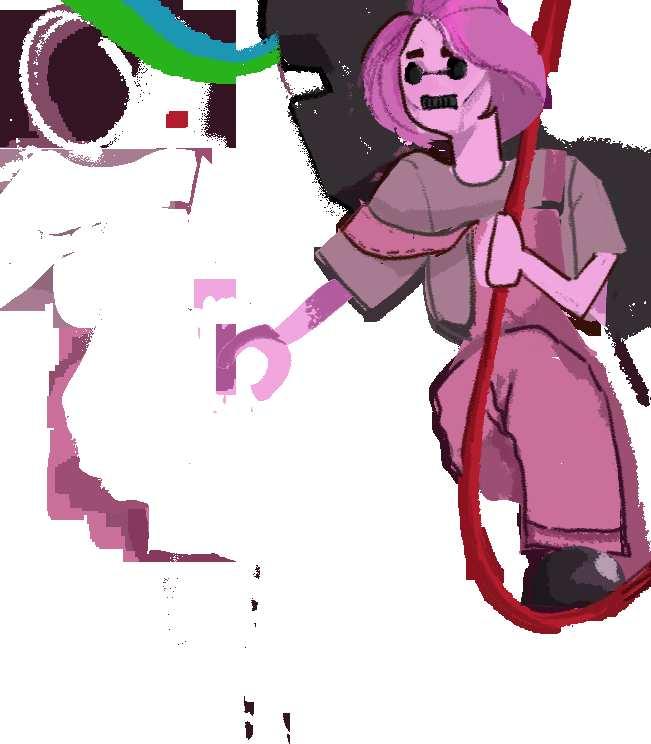

It is 2025, and the Philippines’ “Ghiblification” trend has turned selfies, bahay kubo, and even the stern gaze of infamous figures like Ferdinand Marcos Sr. into animeinspired animations. But beneath the viral glow lies a struggle as old as art itself: Can technology amplify creativity without erasing its soul?
Filipino social media feeds brim with AI-generated jeepneys soaring through cotton-candy clouds and bahay kubo nestled under lavender skies. Restaurants like Lola Nena’s briefly jumped on the trend, posting Ghibli-fied cheese donuts before removing them from their feed— perhaps sensing the unease simmering among artists.
For every user reveling in nostalgia, there are creators like Joy Cardaño, featured in a report by NBC, who

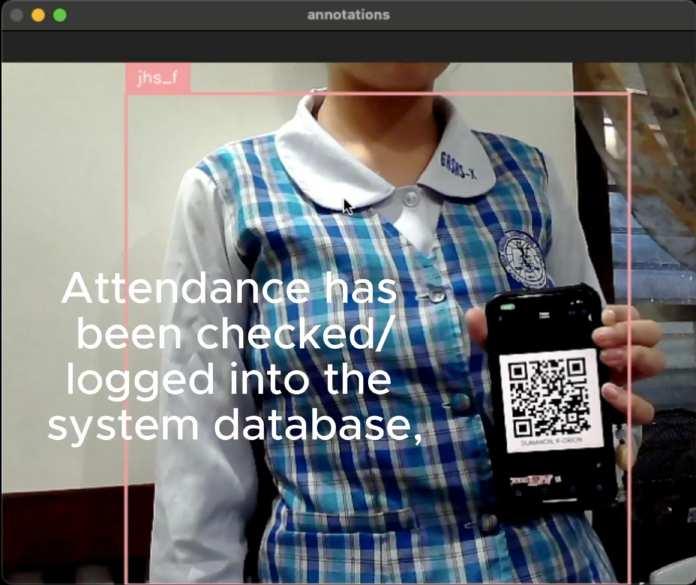
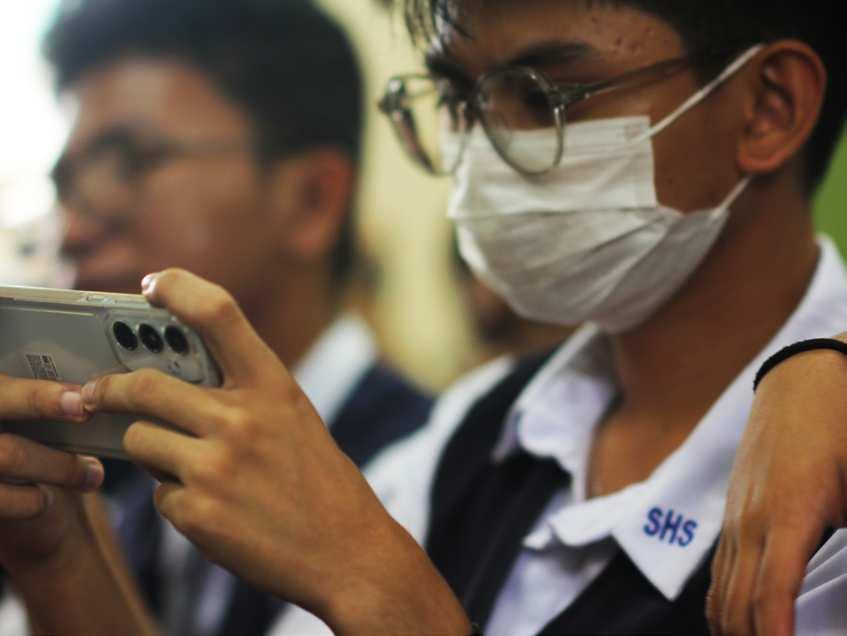
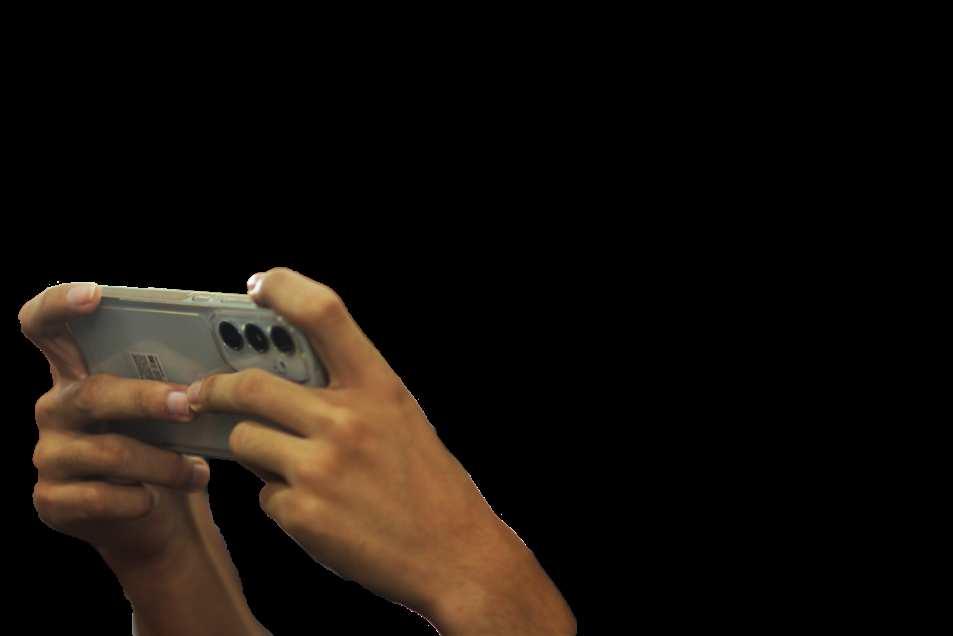
she says, echoing concerns aired in Rolling Stone Philippines about AI’s “ethical vacuum” when repurposing cultural symbols like batok tattoos or banig weaving patterns.
Hayao Miyazaki’s 2016 public condemnation of AI in an article published by Rolling Stone Philippines as “an insult to life itself” haunts this trend. The Studio Ghibli co-founder, known for hand-painting watercolor storyboards, once dismissed an AIgenerated zombie march as “pathetic.”
His ethos collides with OpenAI’s tools, which avoid mimicking living artists but freely replicate studio styles.
Forbes notes the irony: Ghibli’s films often critique industrialization, yet AI reduces their aesthetic to “algorithmic karaoke.” Manilabased illustrator Pattpiha argues in a commentary with Rolling Stone Philippines, “AI should support us, not replace us,” while artist Rob Cham scoffs at the “hot buzzword”

flawless animations—and tragedy in what it erases. These vehicles, adorned with Catholic saints and pop culture icons, embody the Philippines’ “make-do” spirit. “AI can’t replicate the jeepney driver’s stories or the banig weaver’s calloused hands,” says Karlos of Into the Garden Studio. The Philippine Collegian warns that AI risks reducing heritage to “aesthetic loot,” divorcing motifs like batok from their tribal significance. Even LinkedIn optimists like Ayush Shukla, who praise AI’s democratizing power, can’t silence artists fearing their work will become training data for machines.
As debates over copyright and “AI washing” intensify, Filipino creators demand policies that protect human artistry without stifling innovation. ABS-CBN reports lawmakers grappling with how to regulate tools that remix culture at lightning speed. Yet, in workshops from Komiket to Common Room, illustrators like Micress and
For now, the Ghibli AI wave remains a cultural Rorschach test: Is it a tool for playful expression, as a Reddit user’s viral jeepney-in-thesky image suggests, or a harbinger of creative obsolescence? Society must stand with artists to redefine rules and preserve the heart and soul of their works.
Much like Elphaba in “Wicked” who chooses to fight to retain her individuality in a world that demands conformity. As the sun sets over Manila, casting golden light on both hand-painted murals and smartphone screens glowing with AI art, one truth emerges—Filipino creativity, like Miyazaki’s beloved forest spirits, refuses to be easily tamed.
Photo from 11-ENCARNACION FB PAGE


NorMin’s Bold Leap into Future Tech
by JILLIANA MICLAT
In a powerful display of creativity and forward-thinking, Northern Mindanao (NorMin) is stepping into the spotlight , proving that Filipino innovation is not just alive, it is evolving beyond expectations. Through a newly launched exhibit featuring groundbreaking products and technologies , NorMin shows how local regions are taking bold leaps in reinventing what Filipino ingenuity looks like in today’s world.
The Northern Mindanao Regional Innovation Program and Exhibit (NorMinRIPE) 2025, which took place on April 21-22, highlighted a variety of products and technologies that demonstrate the region’s commitment to economic development, sustainability, and technological progress.
Among the notable displays was a coconut tree climbing robot, a dynamic gripper robot, and a robotic arm cutter created by a group of Computer Engineering students from St. Peter’s College in Iligan City. This robot automates the processes of climbing, harvesting, and cutting coconuts, providing a safer and more efficient option compared to conventional manual techniques.
“Nagkagamay ang ma-harvest, kana ang problem and naka-think mi, why not magcreate mi og product nga mu-harvest sya. Safe pod sya, pananglitan mukatkat ta in-kaso lang di man malikayan plus danlog ang kuan, isa pod sa delikado ana while gakatkat sila, ang sanggot naa ra sa kilid gibutang,” Zuri Manogura, a team member, said while explaining their research. This idea prompted them to develop a prototype product that can automate coconut harvesting.
(The harvest is getting smaller—that’s the problem. So we thought, why not create a product that can do the harvesting? It’s also safer. For example, when climbing, accidents can’t always be avoided, and the trees are slippery. One of the risks is that while climbing, the sickle is just placed on the side.)
Another team, the Regional Agri-Aqua Innovation System Enhancement, showcased prototypes and results from its consortium partners, along with the Agri-Aqua Technology Business Incubation initiative of the Department of Science and Technology (DOST)Philippine Council for Agriculture, Forestry, and Natural Resources Research and Development. This initiative fosters agricultural innovation and the commercialization of technology aimed at advancing rural development.
These innovations help reshape and redefine what it means to innovate in the Philippines. Various ideas and innovations are being showcased, helping the community and society to reach the global stage.
As the Philippines moves forward in an increasingly digital and interconnected world, regional lands like Northern Mindanao are proving that true innovation knows no boundaries—only opportunities. NorMin’s bold reinvention serves as a call for the nation: the future of Filipino innovation is not just in big cities. It is being shaped right now, across every region, by the hands and minds of people ready to dream bigger and build better.
CLUCKING ALARMS
The Hidden Health Risk In Every Bite
by JILLIANA MICLAT
Chicken is a staple in Filipino cuisine. Sabi nga nila (They say), you can never go wrong with chicken. Every family in the Philippines loves their chicken—whether it is the famous crispylicious chickenjoy in Jollibee or a bowl of hearty tinola. But what if the next bite can lead to a public health crisis and bring us closer to a world where antibiotics no longer work?
Found in some of the crevices of your food, Salmonella is a type of bacteria that can induce food poisoning to a person. It can cause infections to animals as well as humans. It causes symptoms like diarrhea, fever, and stomach cramps to those infected. Research indicates that salmonella is the primary cause of foodborne illnesses in the Philippines. In 2022, there were 9,000 reported cases, which increased to 13,000 in 2023. Fortunately, Salmonella infection can be cured and in worst case scenarios where the patient has severe illness or weak immune systems, antibiotics may be prescribed to help combat the infection. However, a growing number of Salmonella strains have developed resistance to multiple antibiotics, meaning traditional treatments no longer work against them.
to preventing a future health crisis that threatens not just families, but the entire healthcare system. It can turn common infection into a life-threatening condition especially to vulnerable groups like children, the
from the Pathogen-HostEnvironment Interactions Research Laboratory (PHEIRL) of the UPD-CS IB said after they examined the genetic makeup and AMR of Salmonella collected from chicken meat, the second
education, and more investment on proper research. UP’s study is a wake-up call. With coordinated action among scientists, farmers, policymakers, and consumers, the Philippines


Breaking Barriers and Building Futures
by NEEKA GUILLERO
A nation brimming with potential faces a lack of accessible, quality education. In many rural and indigenous communities of the Philippine islands, this issue hinders progress and perpetuates cycles of poverty, much like a world that judges too quickly, before understanding the full story.
According to the World Bank, approximately 9.4 million people identified as indigenous live in the philippines, constituting about 8.7% of the population.World Bank Country Director Ndiamé Diop emphasizes, “ It is apparent that indigenous Peoples are at a disadvantage in several critical aspects of well-being, including education, labor, access to productive opportunities, gender equality, compared to non-Indigenous peoples.”
The digital divide further exacerbates those inequalities. It is as though society has already decided who is worthy of success, without seeing the true potential of each individual. In the same way, our educational system needs to break free from preconceived limitations and embrace the transformative power of new technologies.
Just as how the young generation continues to defy expectations and challenges the status quo of society, education in the Philippines can break down the barriers of inequality through innovation. Learning-based educational games and AI-powered tools offer a unique solution, acting as efficient conductors of knowledge directly to learners. By adapting to individual learning styles, these games optimize the information flow, ensuring learners receive the right amount of stimulation at the right time—like a spark of magic that ignites their true potential. Imagine a game that can tailor its difficulty to each student’s specific needs, offering support and feedback just when it’s needed most. It is an approach that not only makes learning more engaging but
significantly improves retention. This is our chance to build an educational system where every student has the power to soar, regardless of their background. Recognizing the benefits and challenges of AI in education, the Department of Education (DepEd) is studying policies on its use in schools. Education Secretary Sonny Angara acknowledges, “We at DepEd are really studying the possibilities with AI. It really has many benefits both for teachers and students.” Moreover, AI-powered educational tools can personalize learning experiences, adapting to individual learning styles and needs.
To empower the nation, we must first confront the digital divide, ensuring that all learners have access to the tools that will bring this vision to life. In ensuring quality education
for everyone to access, we too must unite to make affordable devices and reliable internet connectivity a reality for all learners, especially those in underserved areas. In a world where technology connects us more than ever, education-centered applications also help preserve cultural heritage, grounding young people in their roots. Through the integration of traditions and identity, these tools foster a sense of pride and understanding, allowing learners to grasp their place in the world and their potential to shape its future.

A Dose of Doubt

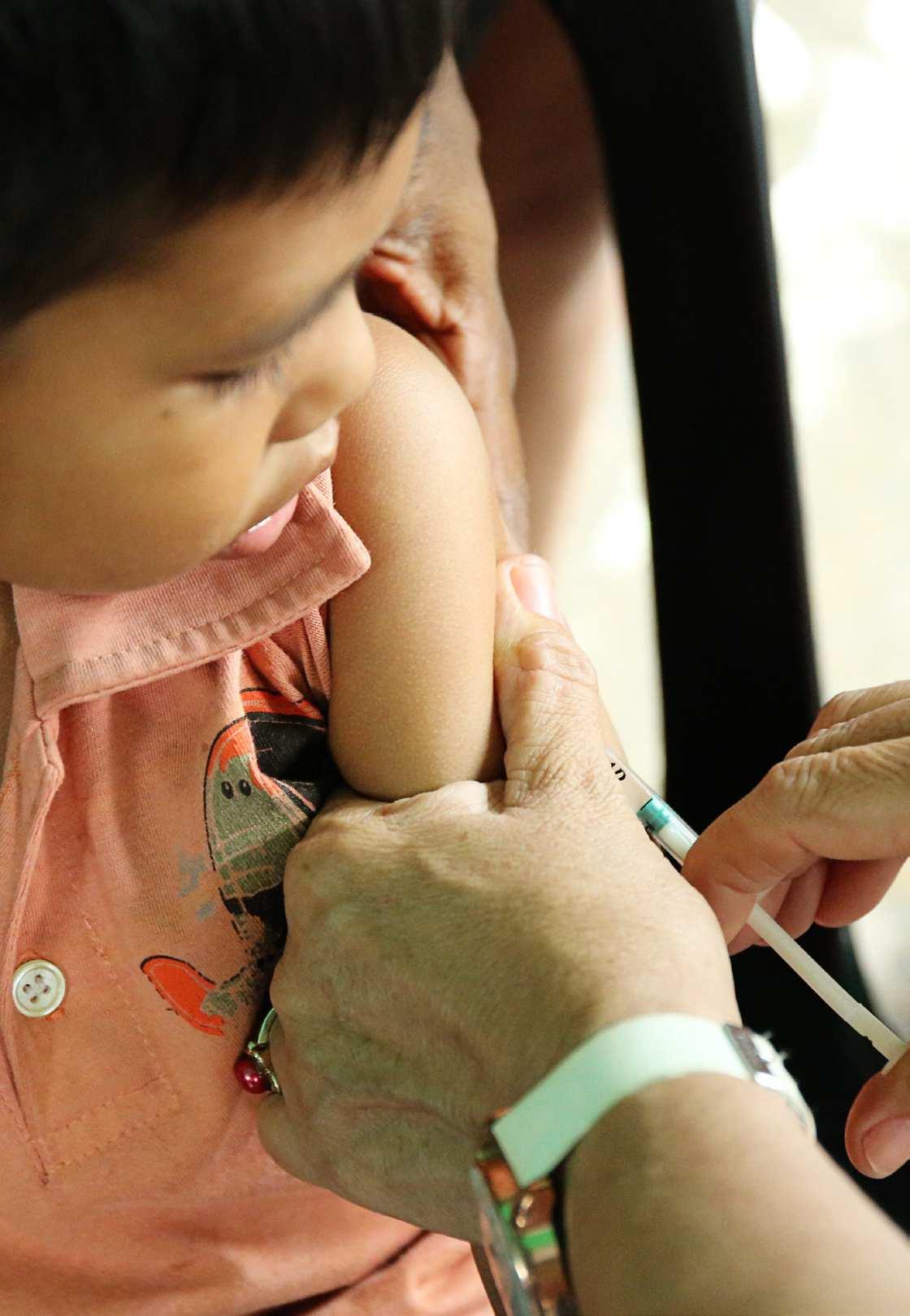
by JILLIANA MICLAT

Prevention is better than cure. A single infected kid can infect other 16 kids. Imagine a superstition or fake news can cost you the life of a child. More than 6 million individuals of younger age die from deadly diseases worldwide. In a world where medicine and modern-day solutions are available, some people are still stuck in a time of traditional remedy. Though it is not bad to stick to the things that we are used to, getting your kids vaccinated is a way for you to keep your children away from deadly diseases.
Of the almost 1.5 million deaths in those 5 to 19 years of age, about 37 of 100 deaths are due to infectious diseases. Most of which are preventable by vaccination. Still, a hidden fear continues to loom over some, for reasons they can’t just ignore. “No, I wouldn’t. I’m afraid of it,” Monalyn Naturan says after her daughter was diagnosed with dengue.
“Based on what I’ve seen, of people and children dying. Even if they conducted further studies about it, there’s still that history that will never remove the fear in me. I just wouldn’t.” she added as the fear continued to loom over her, holding her daughter while beads of sweat fall on her tiny
Monalyn Naturan is a FIlipino mother living in Metro Manila, with her daughter infected by dengue and one of the possible recipients of Dengvaxia vaccine—rejected the vaccine in fear of the worst possible outcome. With thousands of children still not fully immunized, the country is grappling with the consequences of vaccine hesitancy, which is putting lives at risk and straining the country’s healthcare system. Skepticism can win people’s hearts, preventing people from taking the right precautionary measures, resulting in an even
This year, a notable surge of measles-rubella cases in the Philippines was reported by the Department of Health (DOH), with a total of 922 cases from January 1 to

March 1, 2025. With the mix of doubt and misinformation, among the documented cases, 68% were children who had not been vaccinated or had not completed their vaccination regimen. Numerous studies have looked into the factors that lead parents to refuse, postpone, or feel uncertain about vaccinating their children. In one particular study, 77% of surveyed parents indicated that they had concerns regarding one or more childhood vaccines. The concerns voiced by parents are diverse but can be categorized into four main groups. These groups include religious objections, personal beliefs or philosophical viewpoints, worries about safety, and a need for additional information from healthcare professionals. Health professionals are sounding the alarm. Dr. Maria Rosario Vergeire, the Undersecretary of DOH, emphasizes,”Vaccination is a collective responsibility. By not vaccinating, we jeopardize not only our children but also the community at large.”
The rise of vaccine-preventable diseases in the Philippines is a clear sign of the dangers posed by vaccine hesitancy. It is important that we understand that vaccinatig the young generation far outweighs the risks that it comes with being unvaccinated. Vaccines protect not only individuals but entire communities, helping to keep our children safe and healthy. It is time for FIlipino families to trust science, reject myths, and ensure that every child is immunized. The health and well-being of future generations depend on it.


technology, innovative curriculums, and dynamic teacher training can transform the way we learn and teach, lighting the way toward a brighter future. With this new era of learning, we harness the power of innovation and ride the waves of change, illuminating the minds of our youth and shaping a nation that thrives. We can rise above old challenges and create a world where every learner has the opportunity to reach their full potential.

OBVI-OUSLY BRILLIANT
by NEEKA GUILLERO
In the midst of demanding schedules and rigid policies, some students go beyond traditional academic pursuits, seeing research as more than a mere task but as a path to endless opportunities. Mikah Mabulay and Anne Princess Lagradilla, two student researchers from Gusa Regional Science High School-X, are among these driven individuals. Their dedication led to the creation of ‘OBVI.’ With their thirst for knowledge and the guidance of a supportive mentor, this duo triumphed in the regional competition on their first attempt.
With a significant portion of the student body facing issues like tardiness and rule-breaking, OBVI is a visual identification and detection software powered by machine learning AI, designed to assist school administrators in ensuring student safety. Their study shows that the software effectively monitors student arrival times and uniform policy compliance on campus.
OBVI works by using a quick response (QR) code system, a camera, and artificial intelligence to detect and identify students. For the system to function properly, students must wear the correct uniform for the day and have a registered QR code for recognition. If either requirement is missing, the system won’t recognize the student, strongly encouraging adherence to school rules.
“We as researchers and students of RS experience what every other student does. Unavoidably, there are times where we arrive at school late and even get reprimanded for not wearing our uniforms. And ironically, in a way, we thought, why not create something meant to cater toward the students, and provide convenience for
the school administration and prefect of discipline?” Mikah shared their story on how they came up with OBVI.
Inspired by their own experiences and the needs of the student body, Mikah and Anne aimed to make student monitoring easier and more efficient. Now, their project, titled OBVI: Object-Based Visual Identification for Gusa Regional Science High School-X Students, is set to represent Region 10 at the National Science and Technology Fair in 2025. Looking back on their journey, Mikah shared that making it to the national stage with OBVI was beyond belief despite the challenges they faced.
“I think the key takeaway from that experience is to know that
never learning or embodying the material or topic by heart will get you anywhere. Through this, I’d like to inspire many of those afraid to dare that you will always remain prepared if you believe and deem yourself as so.” Mikah and Anne’s story is a testament to the power of innovation fueled by real-world experiences. By identifying everyday problems and creating practical solutions, they prove that young minds are capable of making a meaningful impact. As they continue their journey, they remind us that meaningful change often starts with a single bold idea and the determination to see it through.


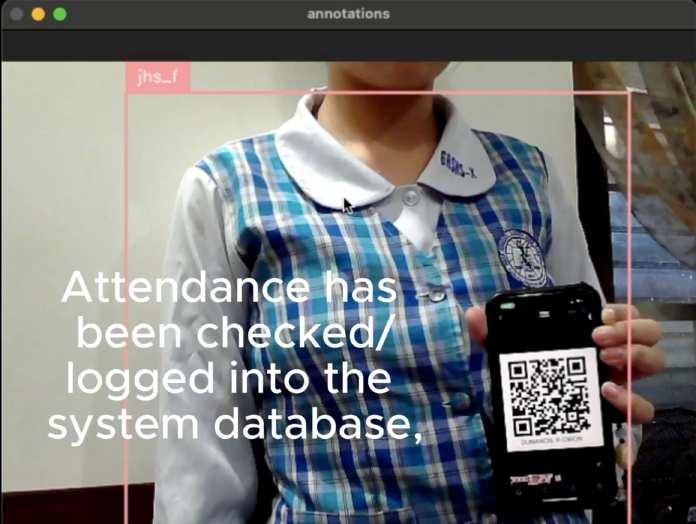




2ndKagay-anInt’lDragonBoatRace
Butuan paddlers glide past foes, snags treble in tourney debut
Butuan Dragons made waves in its first splash in the Kagay-an International Dragon Boat Race, leaving rivals adrift en route to a 1st place finish in the Open 200M, Mixed 400M, and Mixed 2000M categories in Cagayan de Oro’s Isla de Oro last August 10 to 11.
In its second year as one of the city’s big splashes, ten crews took on the challenge across six categories. Davao’s Ricspeed reigned in the 24-Under Open 400M and Open 400M, while Barangay Carmen’s
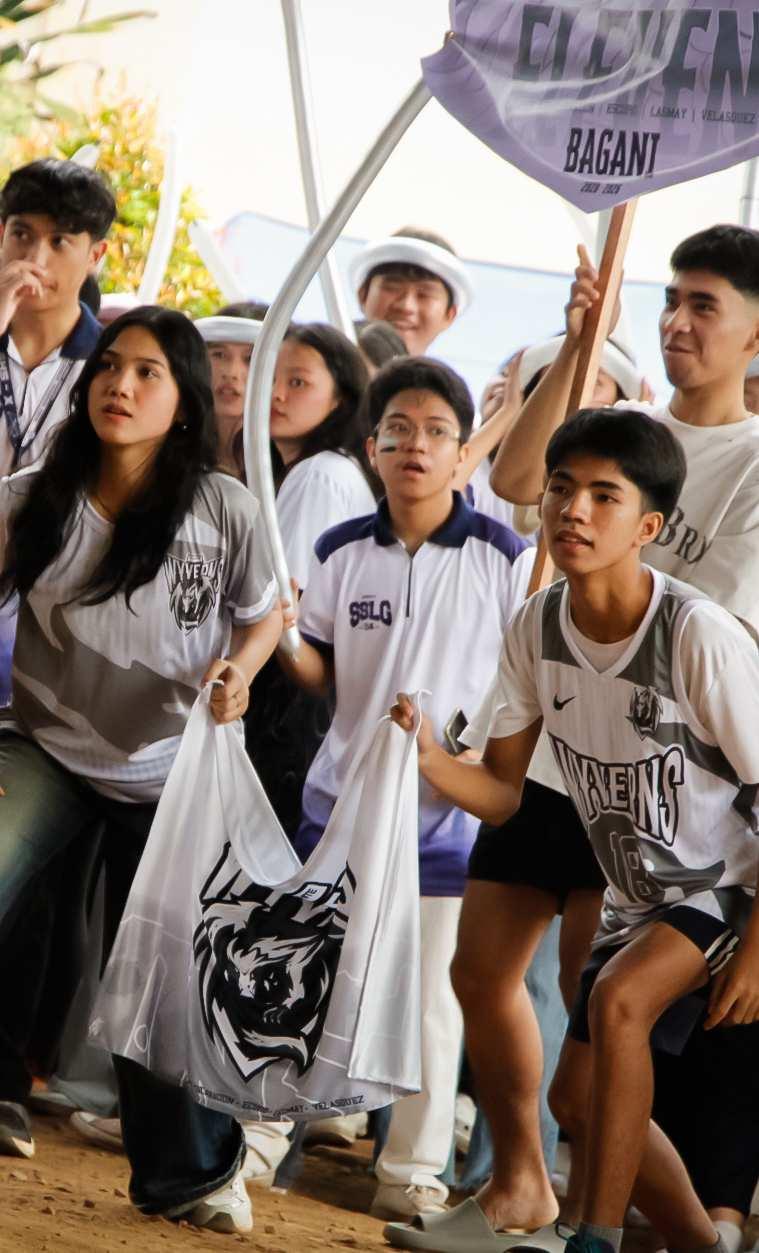
Dragon Boat team claimed first in the 24-Under Mixed 400M. Despite being seasoned veterans, the Butuan Dragons were new to Cagayan’s waters. Fresh from a Bugsay Balangay stint in their hometown last May, the paddlers found new faces to reinforce the crew, prepping for two months before their CDO expedition. Chemistry was key in their smoothsailing victory. “Ayha mi mag training, mag istoryaistorya mi tanan, mag socialize. Pag mag training na usa ra among program, mag sabay ra mi, then
storya napud gamay,” Team Captain Nathaniel Perater shared in an interview. The Butuan Dragons promised to return, ready to make even bigger waves in the next edition of the competition.
INTRAMS RESURGENCE
Wyverns Snatch Mamba’s Throne in Intrams Return
LOIS GICABAO & AHMAD DIMANGADAP
by
After a two-year hiatus, Gusa Regional Science High School-X Intramurals returned with a bang from October 29 to 31, 2024, drawing intense competition and school spirit.
“It’s still very overwhelming. I had doubts if it was possible, but I’m so happy it worked out!” stated the Sports Club President Rushlee Baltazar regarding the event’s success despite the challenges. Grade 11 White Wyverns claimed the overall championship by dominating six events, including a sweep of the e-sports category and both volleyball divisions, dethroning the previous winner the Grade 12 Black Mambas, who finished as the 2nd runner-up, while the Grade 10 Blue Megs secured the 1st runner-up position. White Wyverns swept the e-sports and both divisions in volleyball, securing gold in Call of Duty: Mobile, Valorant, and Mobile Legends: Bang Bang, with Mambas finishing as 1st runner-up in CoDM and Valorant and Megs as 2nd runner-up, while in volleyball, the Wyverns defeated the Megs 2-0 in the Men’s final and won against the Grade 9 Red Raging Zorros in the Women’s final through a three-set match. They also claimed the men’s chess championship and were 1st runner-up in the women’s division, with Henessy Ringel and Gabrielle Ladica scoring five points each for the men, while the Zorros, led by Lara Dalagan and Alyana Gaid, secured victory in the women’s title.
Ending the Wyverns’ win streak, the Blue Megs clinched the basketball championship with a 31-21 victory, while the
Zorros secured 2nd runner-up beating the Mambas, the Megs also dominated the men’s badminton capturing both singles and doubles titles, with the Mambas and Tigers taking 1st and 2nd runner-up, respectively, but the Mambas also triumphed in women’s singles, with the Wyverns and Zorros as 1st and 2nd runnerup. In table tennis, Blissany Torralba of the Megs won the women’s championship, followed by Magalona from the Grade 7 Green Gators in 1st runner-up, Jenshen Chee of the Megs in 2nd, and Salise of the Gators in 3rd place. Grade 7 standout Prince El-jay Medes took the championship title in the men’s division, he expressed his gratitude, “I am very grateful for this award and hope this success continues, so I can represent my class in the next Intramurals.” In the Scrabble championships, the Yellow Tigers won the Men’s title with 284.9 points, while the Megs claimed the Women’s title with 272.40 points, with the Black Mambas seizing the cheer tournament title. Jorizyl Salupan of the Mambas and Rafael Maverick Daroy of the Megs were crowned as Ms. and Mr. Intramurals, respectively. As the district meet nears, Baltazar expresses confidence in the athletes, she said, “I see a lot of potential in many players, not just in my sport but in all sports. Our athletes are excited to represent the school, and I’m glad to see their enthusiasm.”
Friendship, competing in the 250K Higala-ay Festival National Dart Tournament at the City Tourism Hall from August 9 to 11. Alongside the 250 thousand pesos prize pool, the darters are also seeking to move up from their ranks, given that the National Darts Federation of the Philippines designated the tournament
the pairing of Royglenn Macapaz Jr. of WDC CDO and Don Flores outshone 94 pairs in the Classified Draw - Doubles group. SVP-2, composed of John Mark Bracero, Eduard Largo, Joh Ray Sajol, and Vincent Babayen-on outshot 46 crews, taking the Fixed 4 Person Team title. Furthermore, Alex Tagarao of MCDC, Bulua’s Ernie Villa, and Valencia - Tinago
Restobar’s Jon Cantero went away as champions in the Classified DrawTriples division. Opening the final day, Largo won his second title, this time with Boyet Morales of Butuan in the Classified Draw - Doubles. Winners in the Youth and Ladies Singles categories will each take home a cash prize of 4,000 pesos. In the Classified Draw - Doubles, champions will receive 10,000 pesos, while victors in the Triples and Open Singles categories will earn 15,000 pesos. Additionally, the top performer in the Fixed 4-Person Team event will bring home 28,000 pesos.

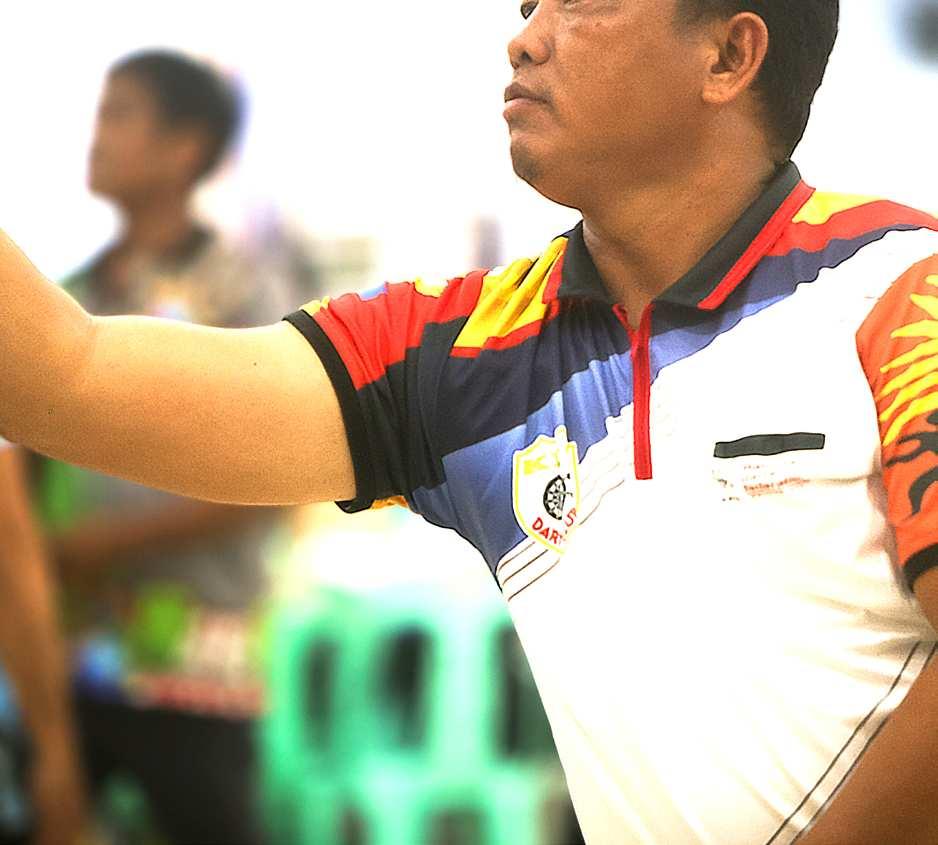
CAGARA
communitynews
LIMITLESS ORCALES
Just like a fine wine being fermented, a student-athlete from Gusa Regional Science High School - X (GRSHS-X) who started taekwondo at a young age, continuously grew as time passed.
Riareese Zoe Orcales, a grade 9 student-athlete of the school who started taekwondo at a young age, has already established a promising career.
Zoe achieved the highest level in taekwondo or the black belt after five years of sacrifices and training and was able to compete in the
competitions she was longing for.
“It was difficult, but not impossible,” the young athlete mentioned.
Orcales made her debut last 2018 in Seongnam City, South Korea during the 7th Seongnam Open International Children Taekwondo Championships where she bagged two golds medals, and four silver medals in kyorugi and individual and team poomsae events.
Aside from the young regionalista’s achievements two years ago, this young athlete has also accomplished the
KEEFINGTHELEGACY
by PRINCE CALIO
Unlike most Southeast Asian countries, football or soccer is not the most popular sport in the Philippines compared to others such as basketball, volleyball, and even boxing. Thus, the sport of football is not as well-supported, causing it to be unsuccessful in the international stages.
But this did not deter
Keefe Aldwin C. Magdato, a graduate student-athlete of Gusa Regional Science High School - X, who continues to pave his own path in the sport. He has been playing soccer since birth as he remarks, “For me I was born with a ball on my feet.”
“Ever since, football has been my sport since my dad and my older brother also play soccer,” Magdato added.
His older brother, Kyle Dominic Magdato, had been a player for the University of the Philippines Men’s Football Team for six years (2015-2021), and was part of the 2016 and 2018 squads that had won the UAAP Men’s Football trophy. Kyle had also been invited to the Youth National Team several times.
Following in his brother’s footsteps, Keefe has been a soccer player since he was three, and he has won several trophies and medals through the years. Like his brother, he was also invited to the U14 Philippine Football Federation Selection National Team 2019.
“Akong dad akong first coach. Permi na dayon ko gadula bisan asa na tournaments around the Philippines and didto nako na develop akong passion for the sport... dream jod nako nga magplay ug professional football,” the young athlete said.
The twelfth grader has seemingly had one of the most promising athletic journeys. Since 2010, he has been active in many tournaments and went on to win his first gold medal in 2016 during the Rizal Football Association (RIFA) Cup.
However, the pandemic has been a barrier to the athlete and any other athletes in their sport. The pandemic hindered most athletes since there were no courts, fields, or gyms that were open.
“The pandemic greatly affected my football career. Tung nahitabo ang pandemic naka stop jod ko ug dula kay walay tournaments and dili na makatraining,” he said.
In terms of academics, the athlete has always been a top student and a consistent Mathematics Teachers Association of the Philippines (MTAP) contender.
“Academics and football were really hard to juggle. Being someone who wants to excel academically and in football, it was really hard to focus on one of them. It would really require proper time management and hard work,” he said as he was asked how he deals with his academics and his sport.
Nowadays, there are many soccer players that are strong and famous, like Messi, Ronaldo, and many more. They can also be the inspiration for many.
But in Keefe’s case, his older brother, Kyle, has been his role model and his sole reason to play the sport.
“Siya jod akong role model ever since gamay pa ko. Kada naa silay dula kay uban jod ko permi and didto ko na inspire mag dula ug football. Gaka amaze jod ko sailang bond as a team and if makadaog sila sa every tournament na ilang gina apilan,” he said.
When asked about how he overcomes the challenges he has faced, Keefe said that being an athlete requires determination, passion, and hard work. To overcome the challenges, you need to focus and believe in yourself.
“Turn negativity into motivation that will drive you

following feats: Gold (kyorugi)
2023 Regional inter-gym TKD tournament (oroquieta city), Gold (kyorugi, individual poomsae, team poomsae) 2023 8th MBCcup International Open TKD Championships, Gold (kyorugi, poomsae) 2024 Regional CPJ Open TKD Championships, Gold (kyorugi, team poomsae) and Bronze (individual poomsae, pair poomsae) 2024 9th MBCcup International Open TKD Championships.
And during last year’s Palarong Pambansa, she qualified for kyorugi. Unfortunately, Riareese
did not reach the podium and settled for none.
As Zoe faced a setback during last year’s run, this young regionalista sets a new goal as the season of athletics will soon start where she eyes for a podium finish in the nationals.
“I want to bring this school’s name once again sa Palarong Pambansa, but this time I’ll try my very best to win gold,” she shared in an interview.
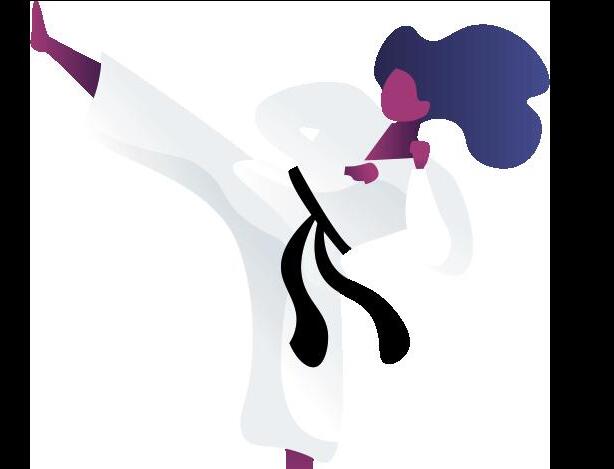
RELENTLESS
RegSci Jins bag 16 medals in Korea MBC Cup stint
by PERKIN
Gusa Regional Science High School-X’s taekwondo quartet of Riareese Zoe Orcales, Christian Dynniel Llenos, Hendrix Mabaylan, and Reyan Scarlet Carbos took over the 9th MBC Cup International Open Taekwondo Championships, taking home 16 medals, including five golden ones, from August 6 to 15 in Taean, South Korea.
bagged gold in Team Poomsae and Kyorugi, while settling for bronze in the Individual and Pair Poomsae categories, whilst Llanos snagged gold in the Team Poomsae category, silver in Individual Poomsae and Team Kyorugi and bronze in the Pair Poomsae.
against a Taiwanese foe, Orcales shared in an interview that she had doubts before the match, facing flashbacks from her Palarong Pambansa run, which she eventually overcame en route to a 11-0 demolition to secure gold.
grader Mabaylan went away with gold in Kyorugi, pair of silvers in Team Kyorugi and Pair Poomsae along with Carbos, who topped the competition in Individual Poomsae and silver finish in Kyorugi.
ever joining an international tournament, it was only natural for me to feel extremely anxious. Despite all my training, I still kept thinking: “What if I mess up?” Carbos shared.
under the guidance of the well-regarded CDO Main Gym, athletes benefited from the leadership of esteemed South Korean Head Coach, Mr. Moon, who’s known for fostering high-level sportsmanship and excellence, and maintaining a strong bond with the local athletic community by regularly supporting and guiding athletes

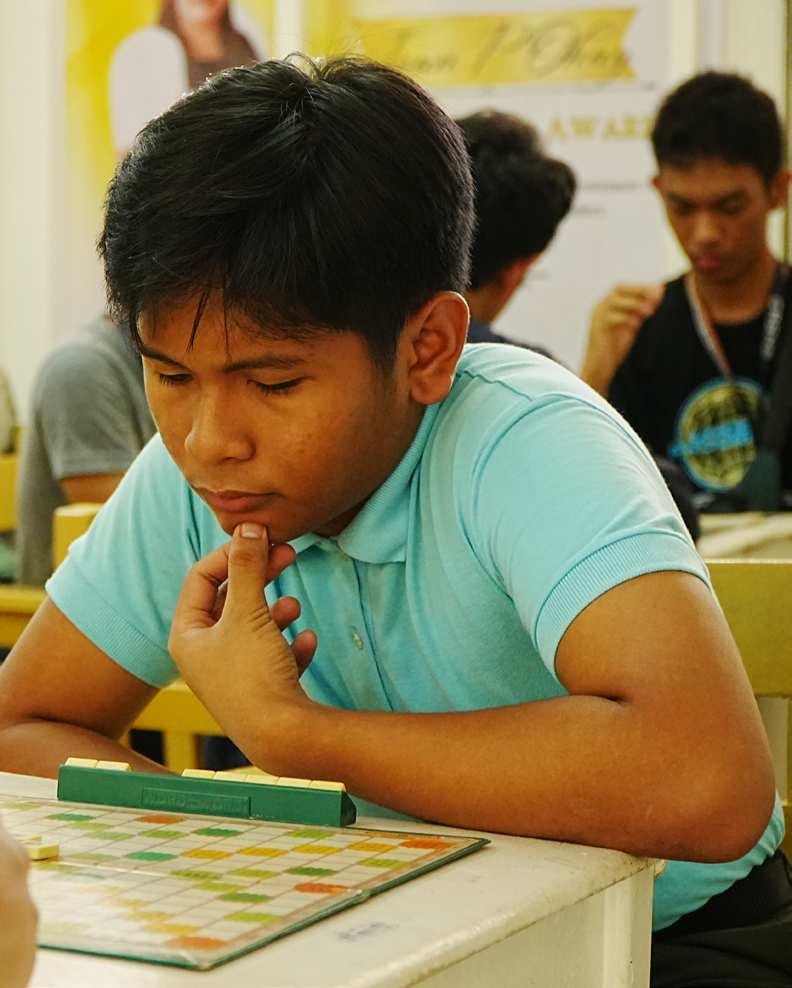
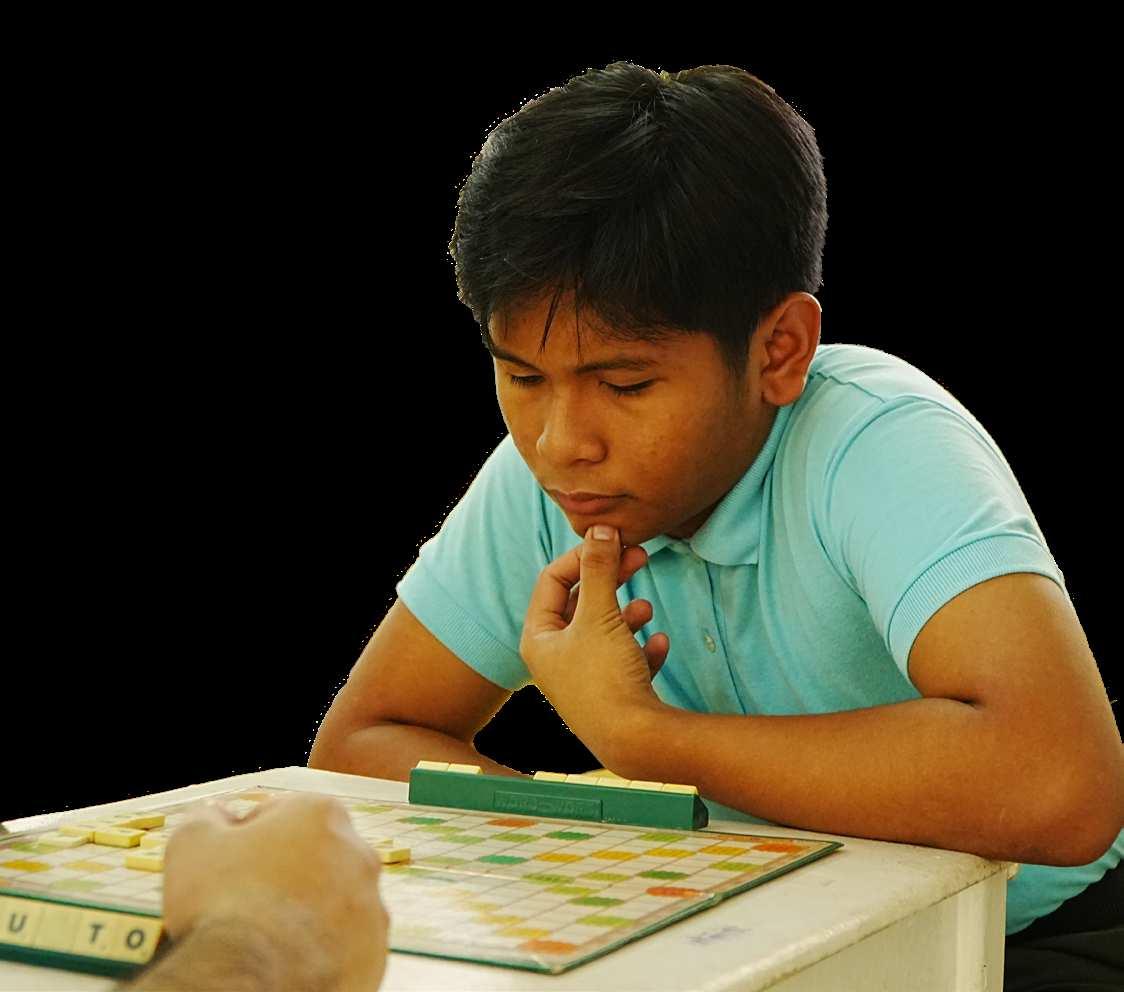
REJINALISTAS Crossing BOARDers
Intramurals’ promising addition
Two years ago, a bright innovation lit up Regionalistas’ appreciation for deep vocabulary and complex strategies. Scrabble in the Intramurals gave learners across different grade levels a venue to showcase their profound ability to form the best words out of a jumbled bunch of letters, but how did a board game find its way into the school’s premier sporting event? In 2022, the Cardboard-RS Guild, a club dedicated to the enjoyment of cardboard games, launched the popular “Borrow-A-Box” initiative, allowing members to borrow from a shared collection of games, in which
Scrabble quickly became one of the most borrowed games. Recognizing its popularity, the school’s committee approached Club Head Mohammad Yasser Datu-Dacula in the club’s first year to include Scrabble in the intramurals. With its success during its first rodeo, the club turned it into a foundation for future events, leading to its first-ever standalone tournament, “Scrabble Showdown” But its inclusion in the sports fest didn’t come without hurdles along the way. On the day of the intramurals, unexpected news came through
by PERKIN CAGARA
that there will be huge changes in the format, where in response, the facilitators discussed the matter with the event coordinators, advocating for a format that would allow fair participation for all players.
“We wish to make the art of tabletop games more mainstream in our school’s culture even further through opportunities such as the Intramurals,” he added.
From one successful tournament to another, the 12th grader CardboardRS Guild Head is looking to boost the popularity of not only Scrabble but board games in general, encouraging fellow Regionalistas to delve into the world of tabletop games.



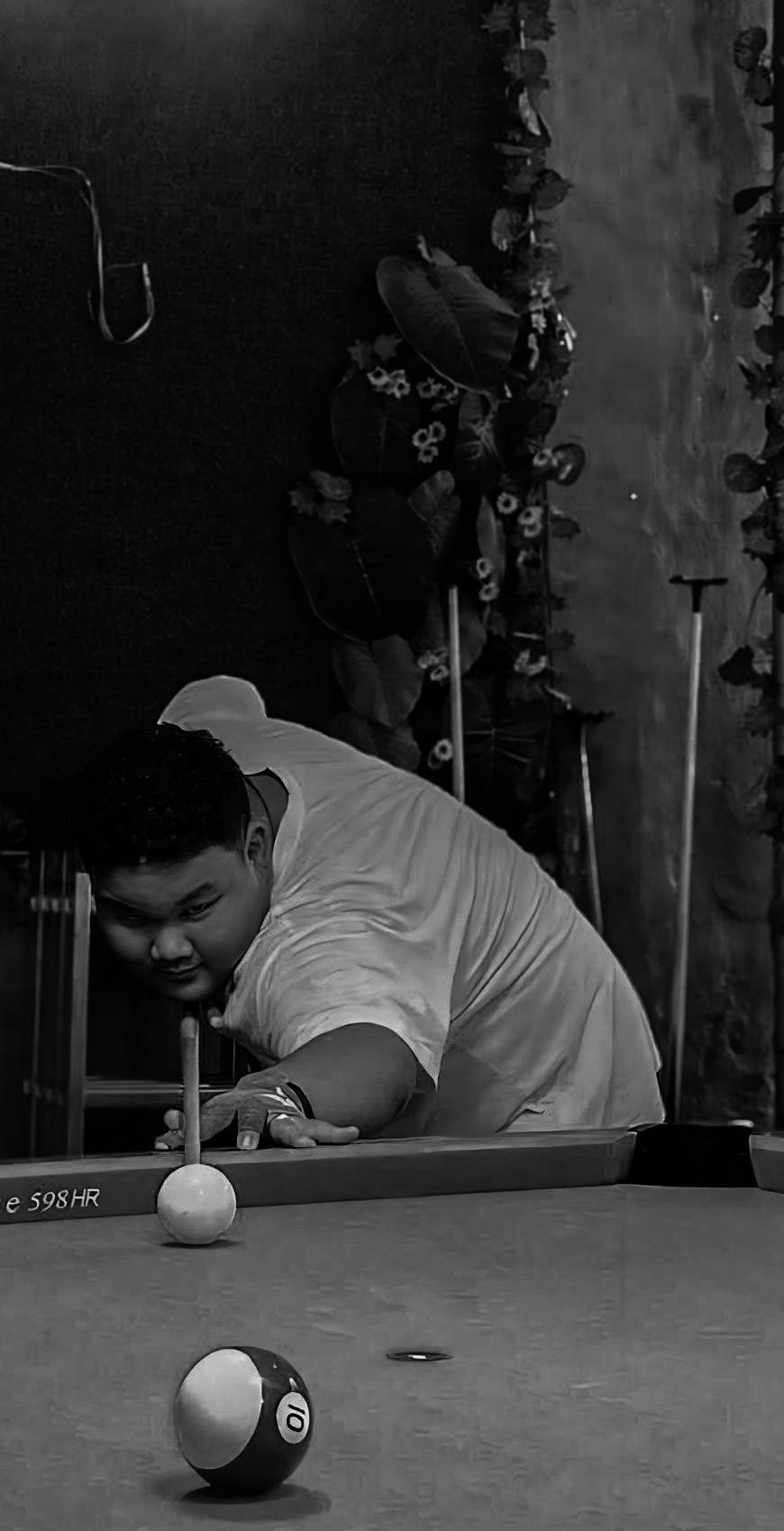
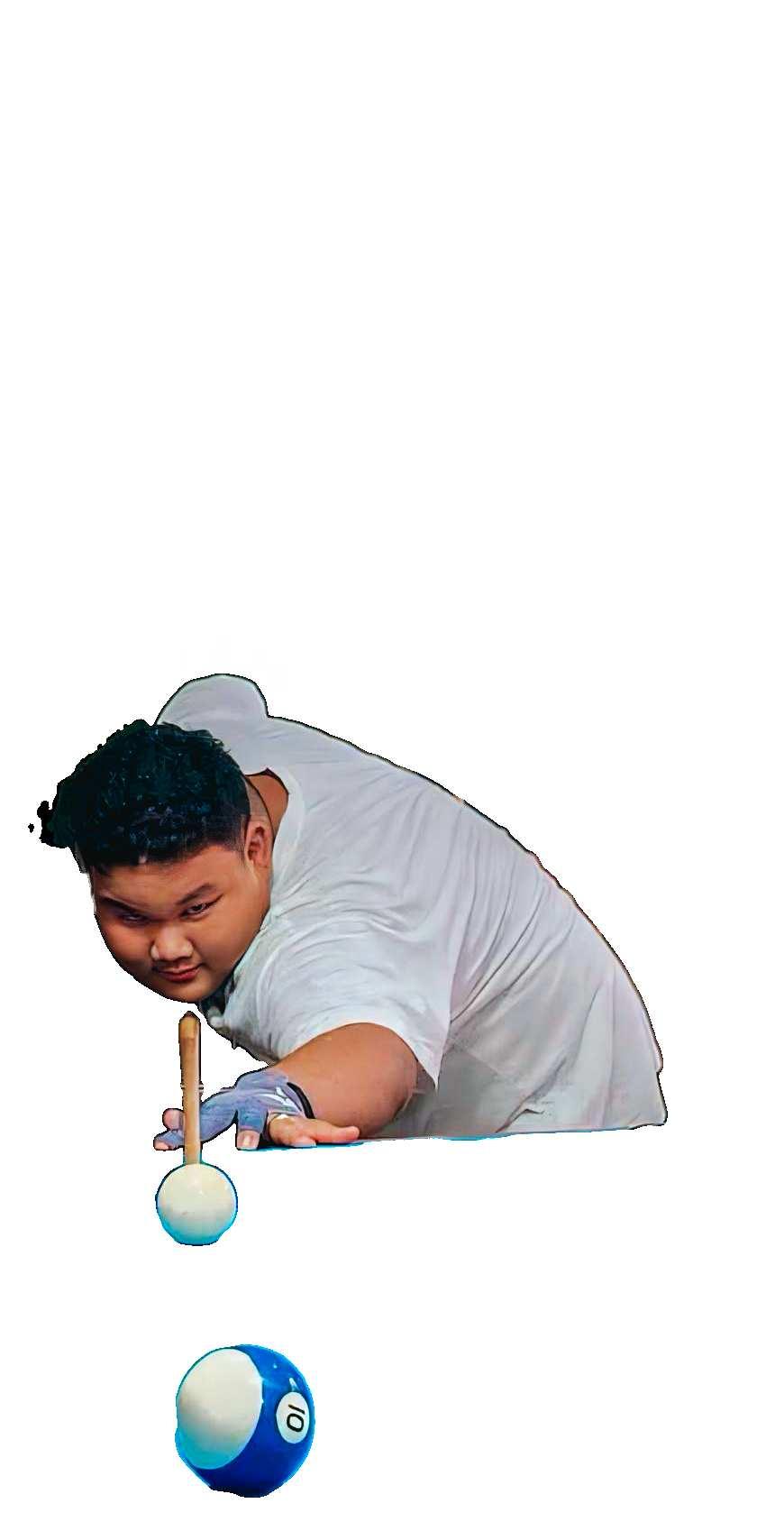
GRSHS-X Boys, Girls eke out first wins after half a decade in District Volleyball
winlessness in this year’s edition of East I’s District Meet, marking their first victories after half a decade, capped off with a Boys semis and Girls finals finishes at Capitol University Basic Education’s Covered Court from December 8-9, 2024.
RegSci’s volleyboys avenged last season’s early exit, booting Lapasan out of the tournament with a 25-13, 22-25, 15-13 nailbiting victory to advance onto the semifinals.
Being a member of last year’s crew, team captain Blaine Aleria shared that the squad felt satisfaction after their win, looking back at last season’s shortcomings, with setter Charles Real adding that he couldn’t allow themselves to lose against LNHS in the first round again.
“Due to our busy schedules, Blaine and our coach, Sir Jericho Pareño, organized drills and exercises to maximize our limited training time. With conflicting class schedules, morning students trained in the afternoon and vice versa. When excused, we trained all day for three days, focusing on
ike a cue ball precisely defying the odds, this young talent lined up their snooker at the right time, seized the moment, and claimed a well-earned victory.
Ken Gabriel Cardona, a freshman student-athlete of Gusa Regional Science High School - X made a successful debut as he claimed his first tourney win as a Regionalista during the 2024 East I District Meet last
The influence from his father and hometown made this young pool player start his journey of playing this sport. Ken was eight years old when he started to play and realized that he is happy and wanted to be a professional billiard player.
“My main hardship are balancing my time practicing/playing to improve while maintaining my academics,” ken mentioned.
Despite the hardships he claimed, ken added “Still, playing this sport removes my stress and makes me
Ken has already accomplished multiple achievements outside the school, including: 2022 inter barangay - champion, 2024 SK inter barangay - champion, 2024 BBQ SA
id

less than a month to prepare,” said three-year vet John Emmanuel Dulangon II shared.
Asked about the changes that led to their win, Dulangon shared that the team’s strength lay in its roster, with a skilled setter, strong blocker, and excellent hitters. The players’ familiarity and close bond also led to better teamwork and connection compared to before.
On the other hand, RS’ volleybelles opened their campaign with an easygoing 25-12, 25-19 win against the Magnificos of FS Catanico Nat’l High School, followed with a 25-8, 25-8 demolition of University of Science and Technology of Southern Philippines to reach the finals.
Despite the boys and girls falling short in the semis and finals respectively, both to CUBED’s volleyball teams, leaving the meet with marks on the win column leaves a lasting impression to kick start a bright future for the Ravens.
“People should watch out for the next batch of players.. expect to see our school shine once again in volleyball, just as it used to,” Dulangon II stated.
EDITOR’S PICKS
When these ravens shape RegSci sports scene
I am Prince Janiño Calio, Editor-in-Chief of Nudo Veritas.
Since seventh grade, I’ve been a sports writer, covering the stories, wins, and losses of GRSHS-X student-athletes.
Over six years, I’ve witnessed some of the city’s finest athletes breaking records, scoring high, and earning medals. Here are a few remarkable athletes I’ve encountered during my journey.




SPORTS

